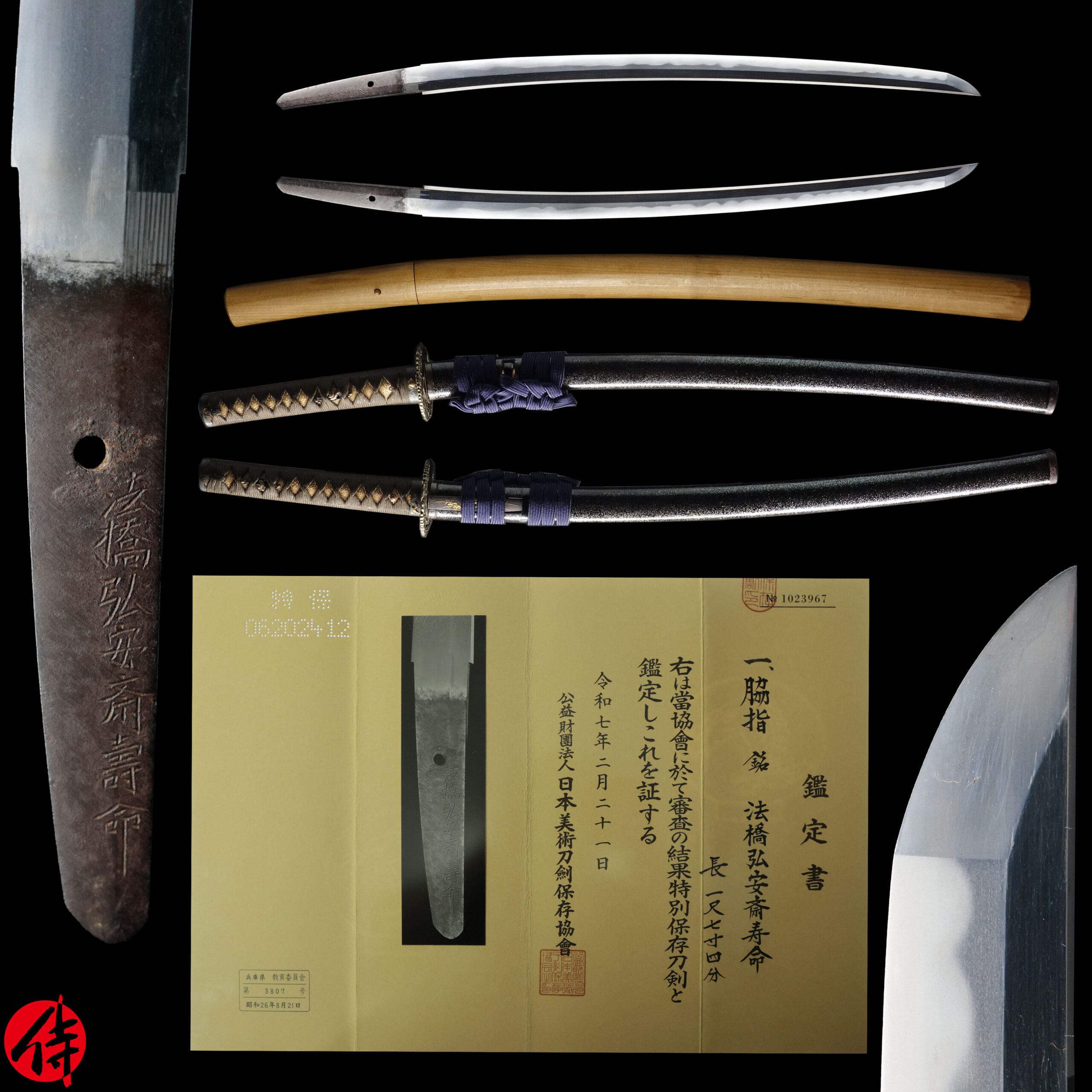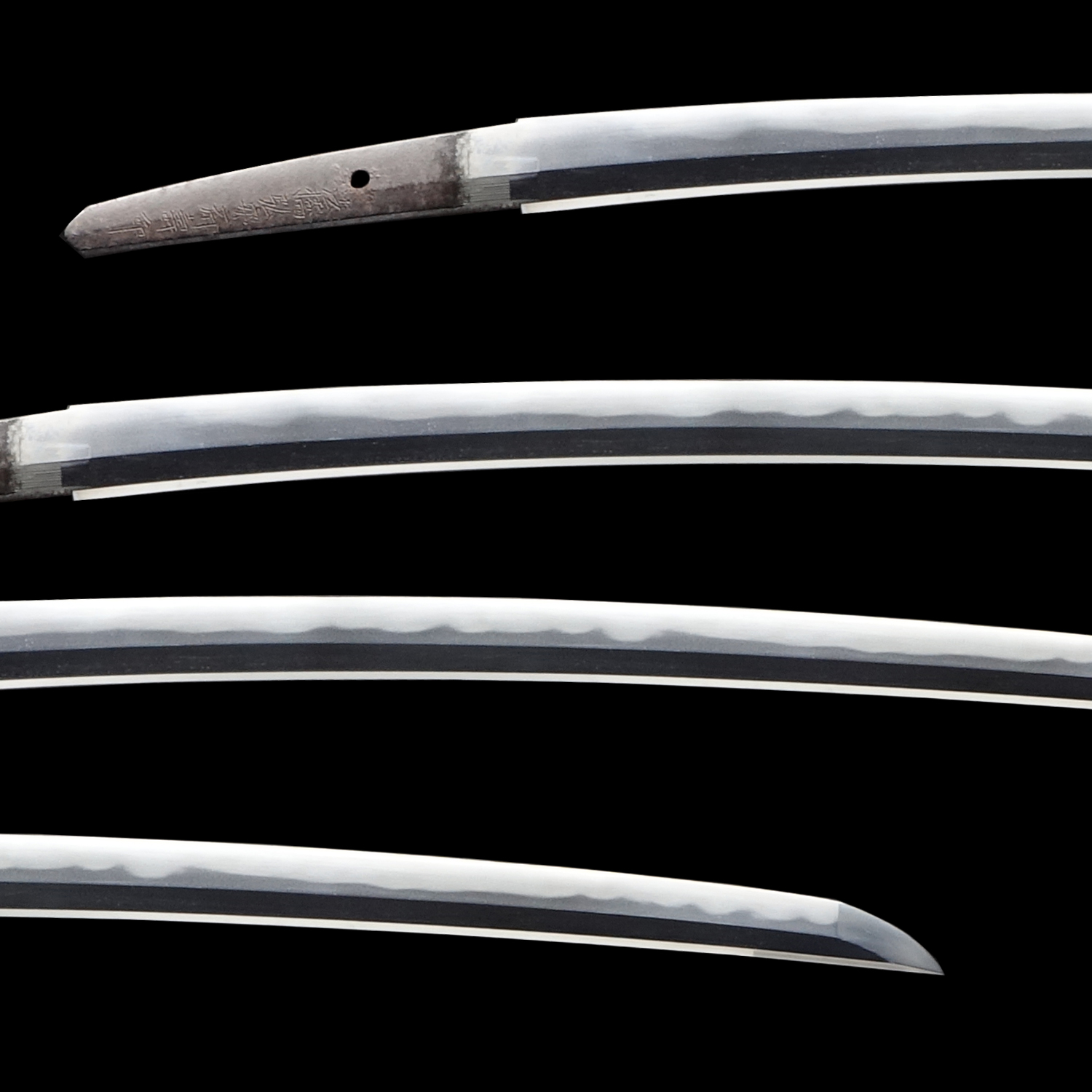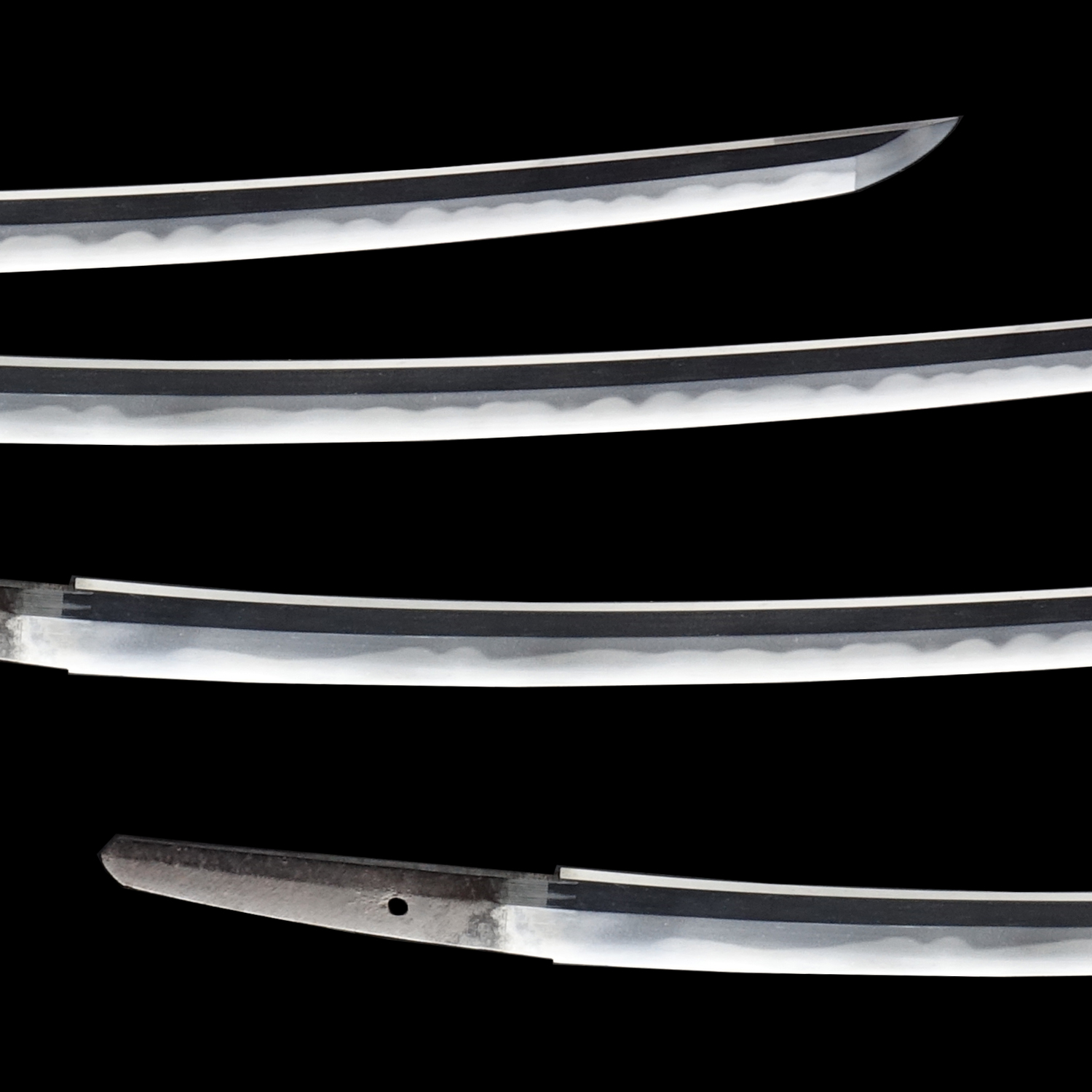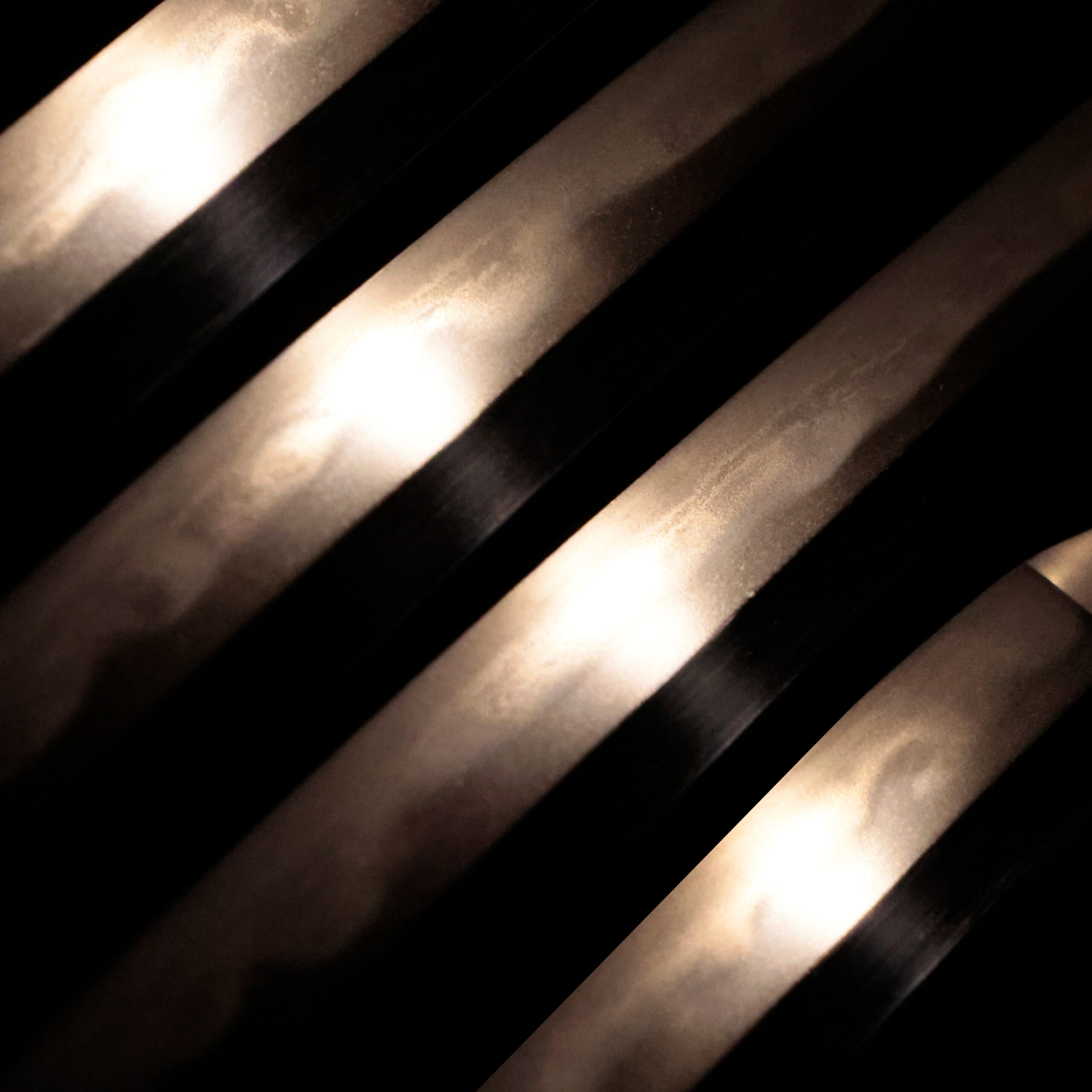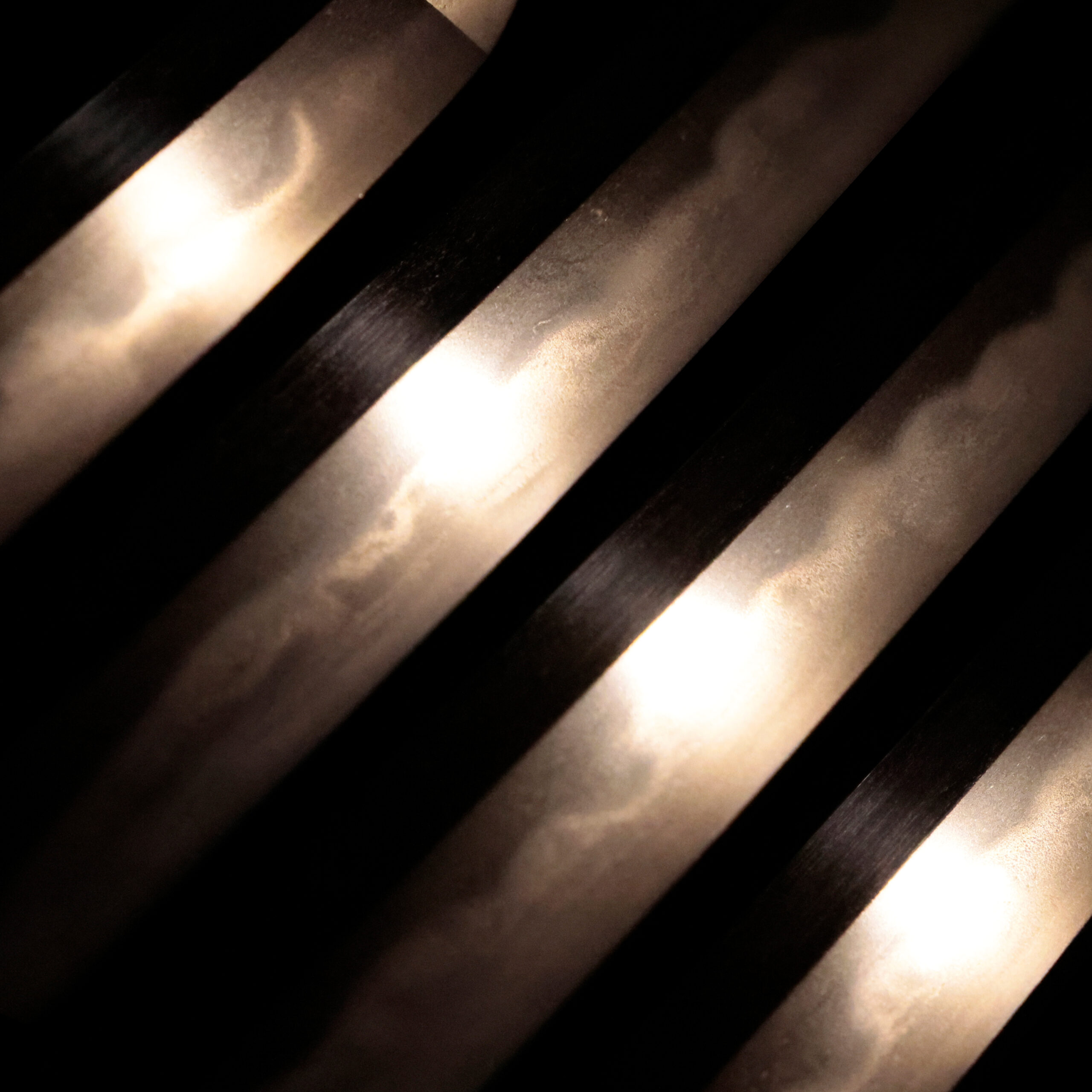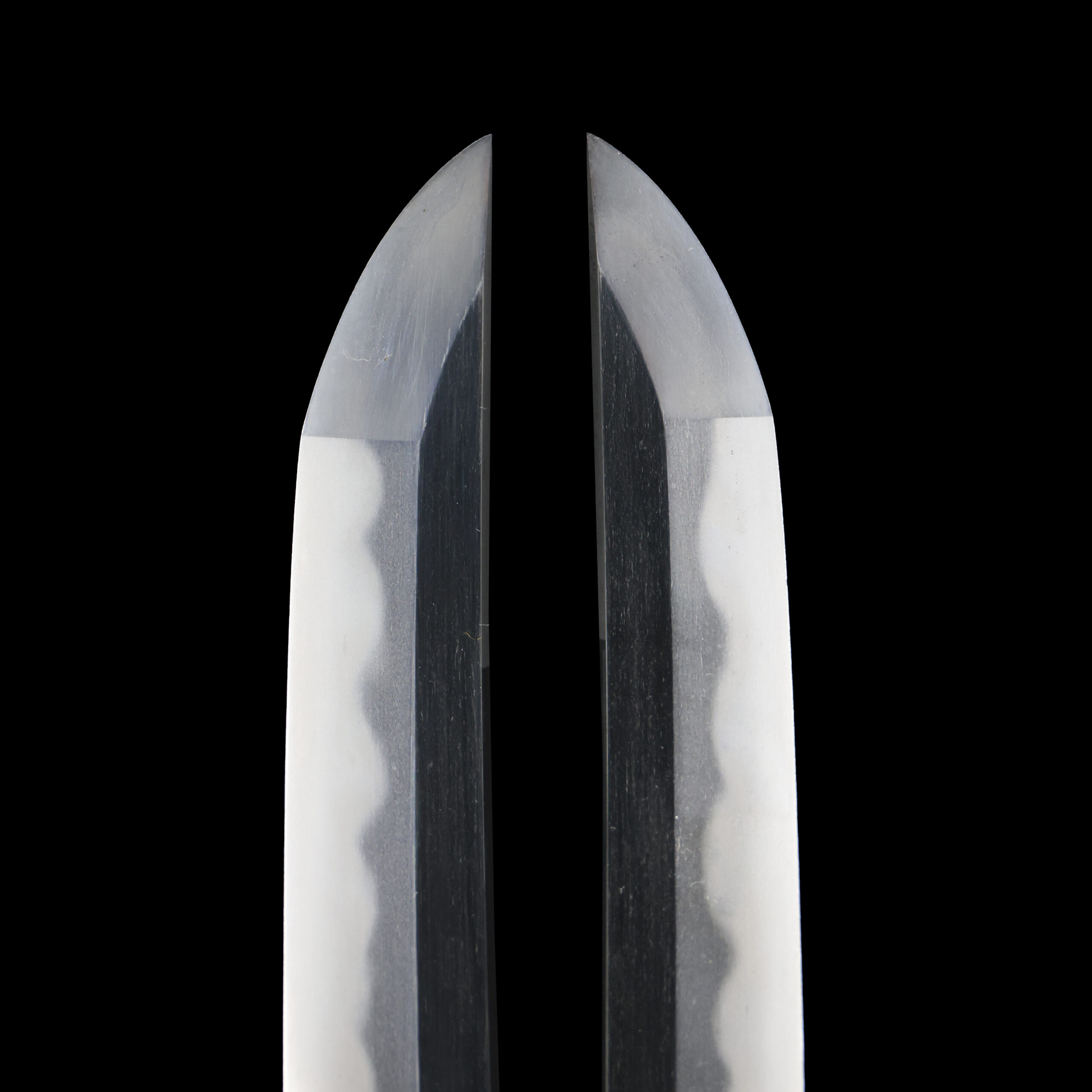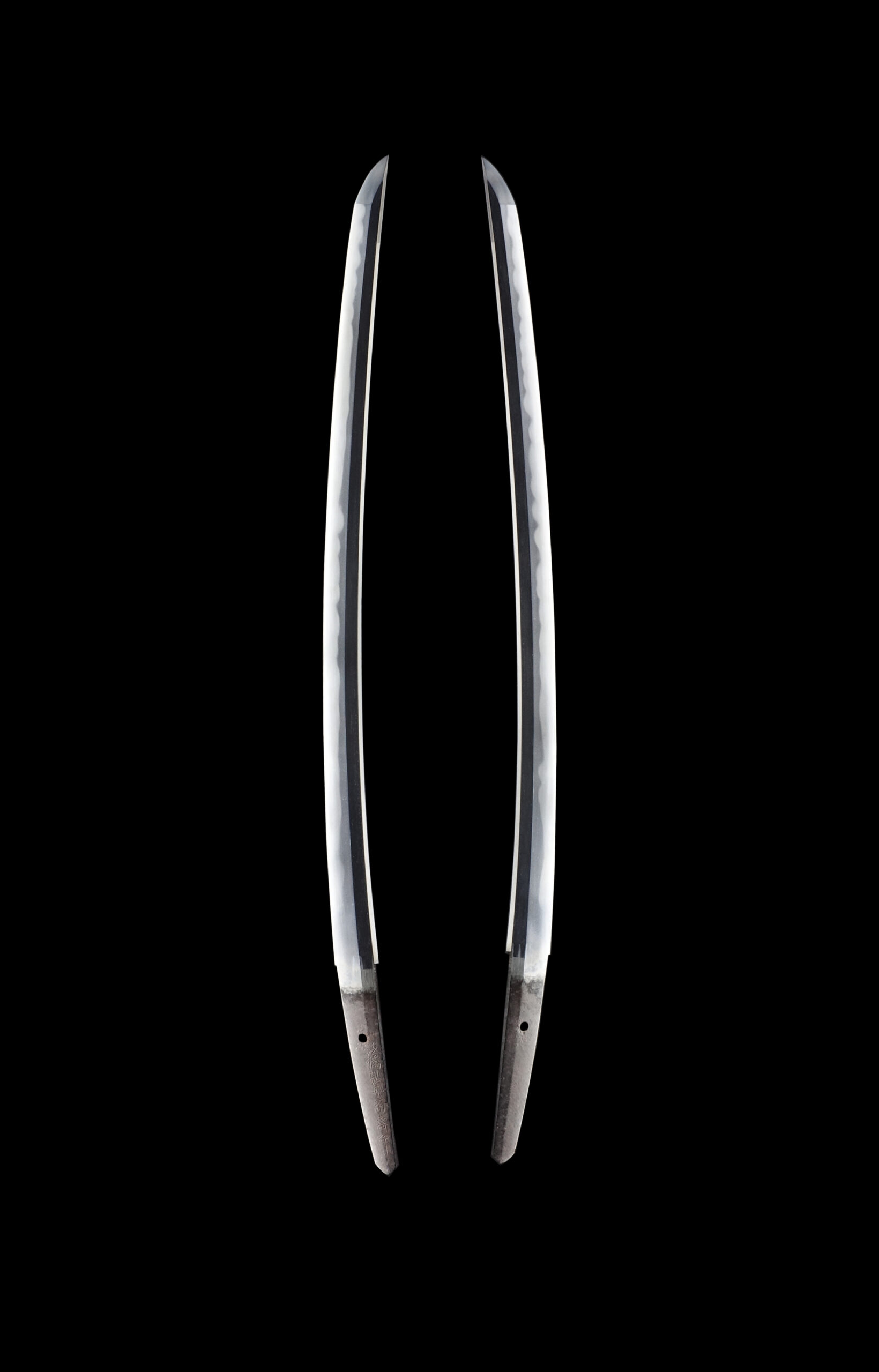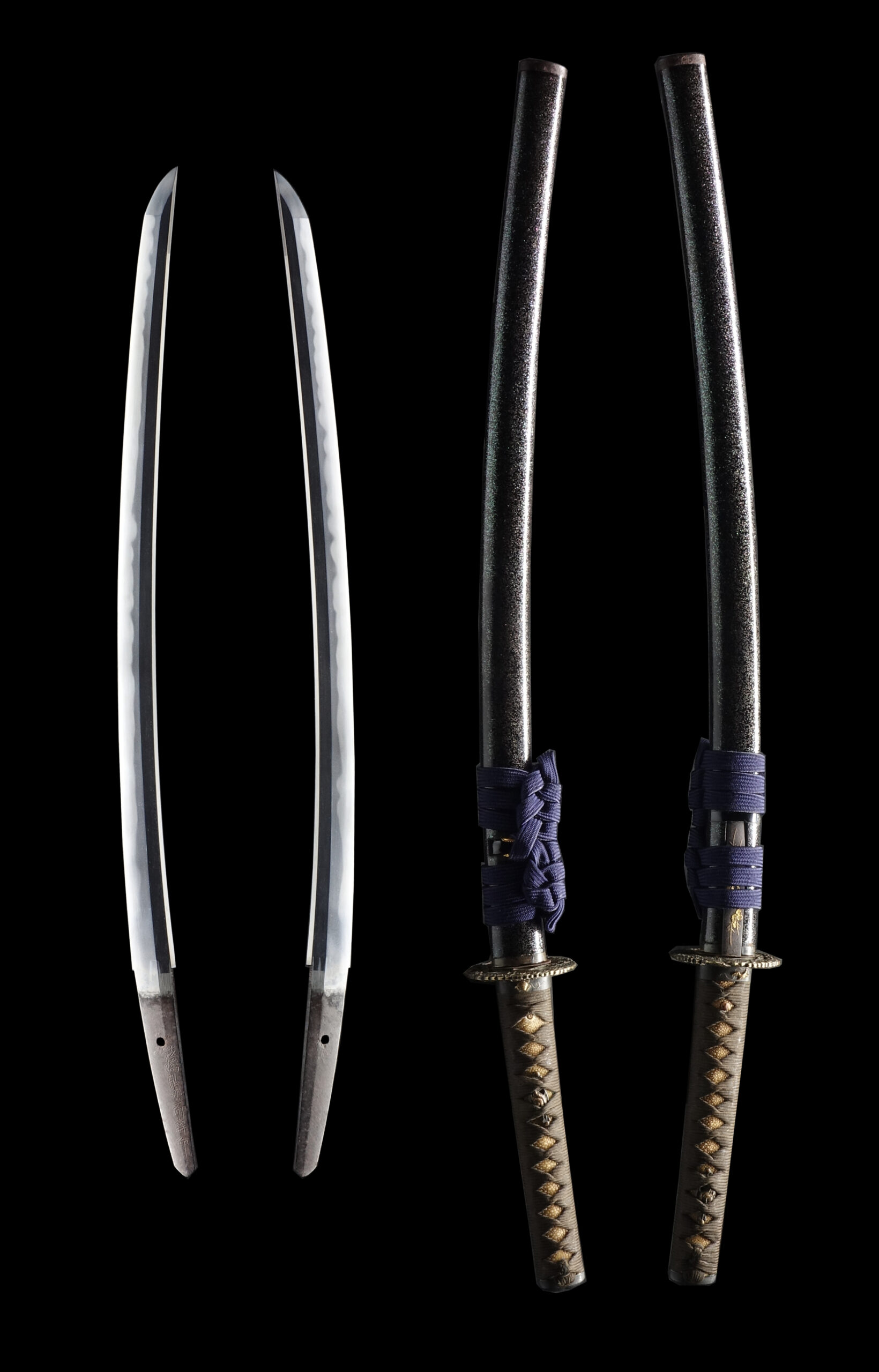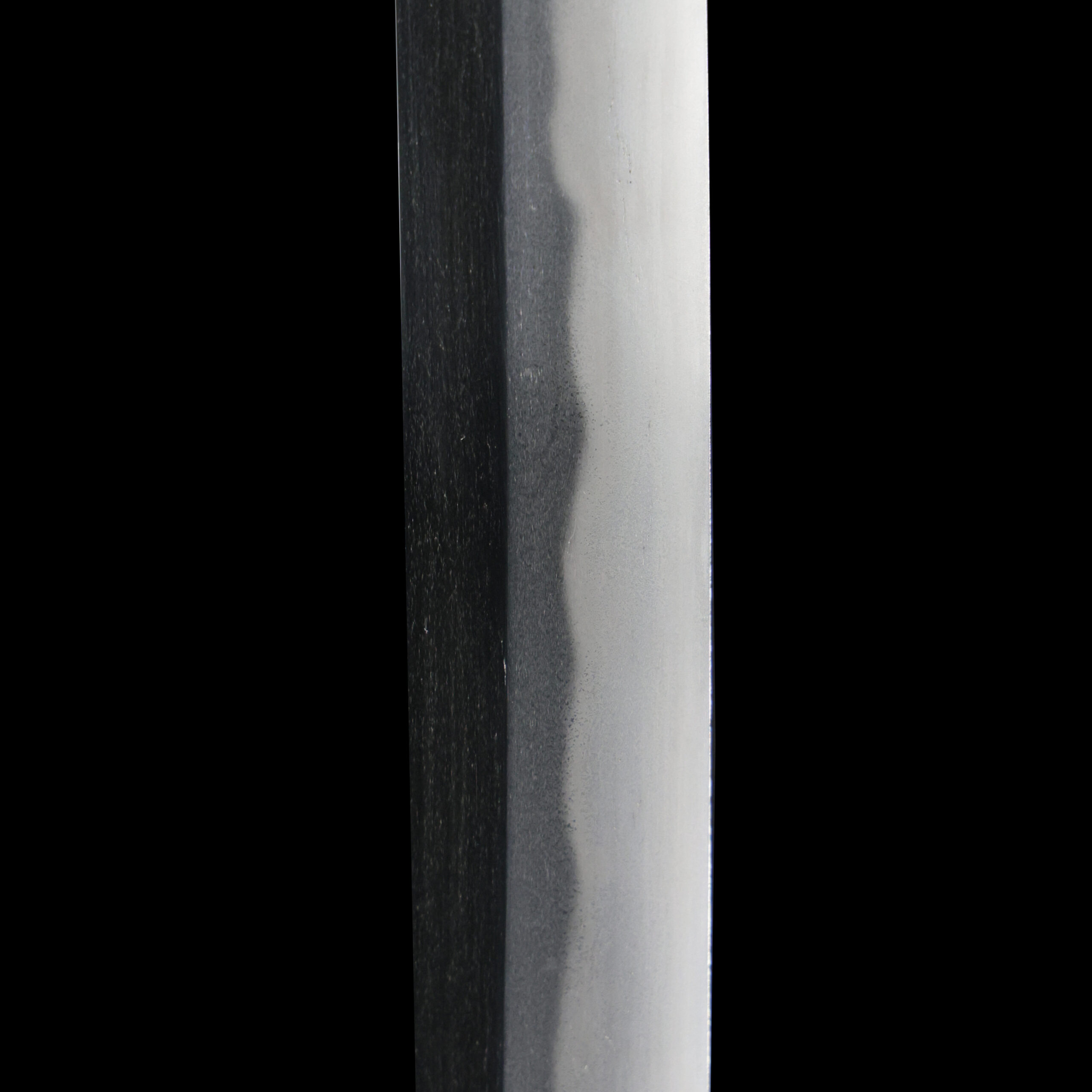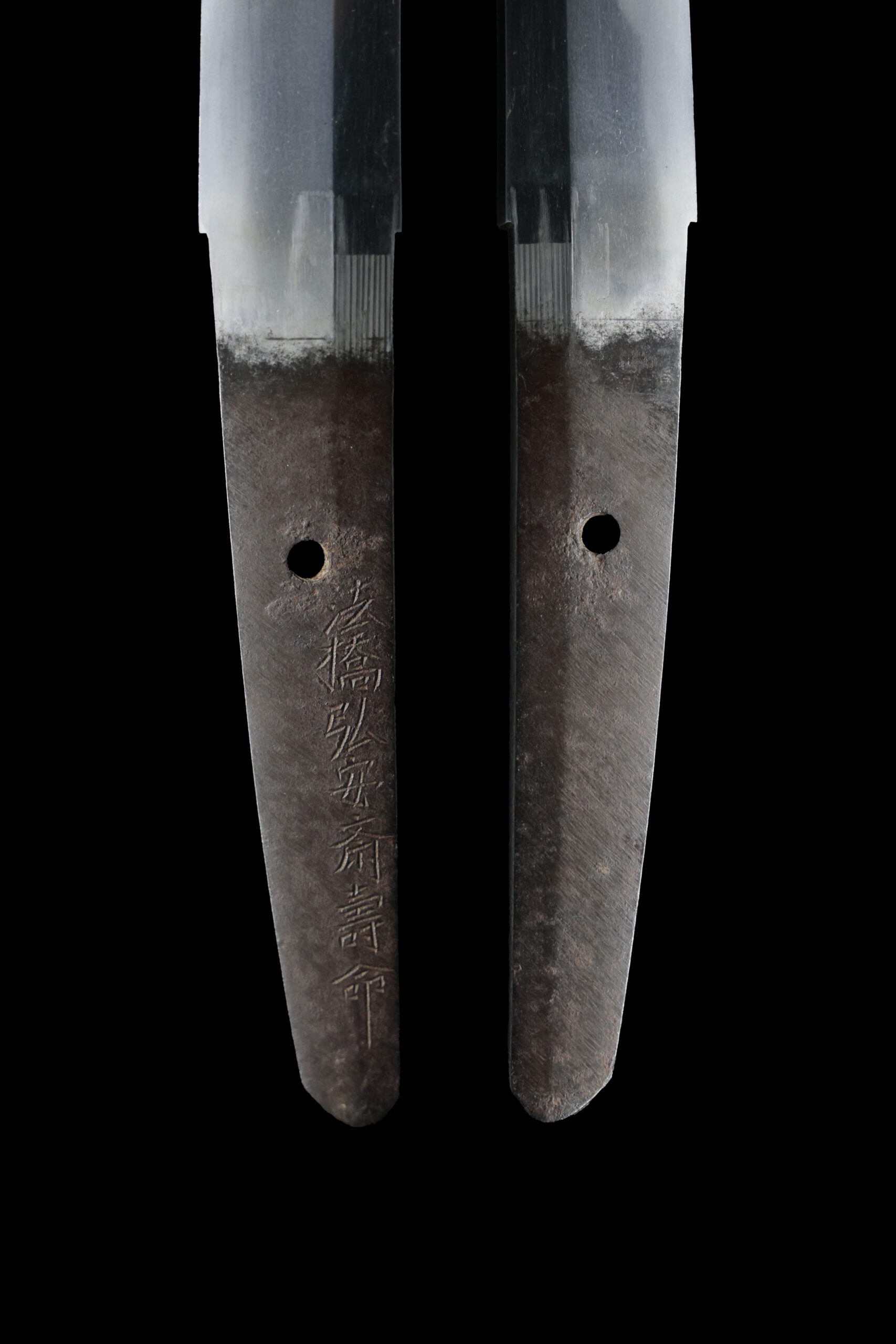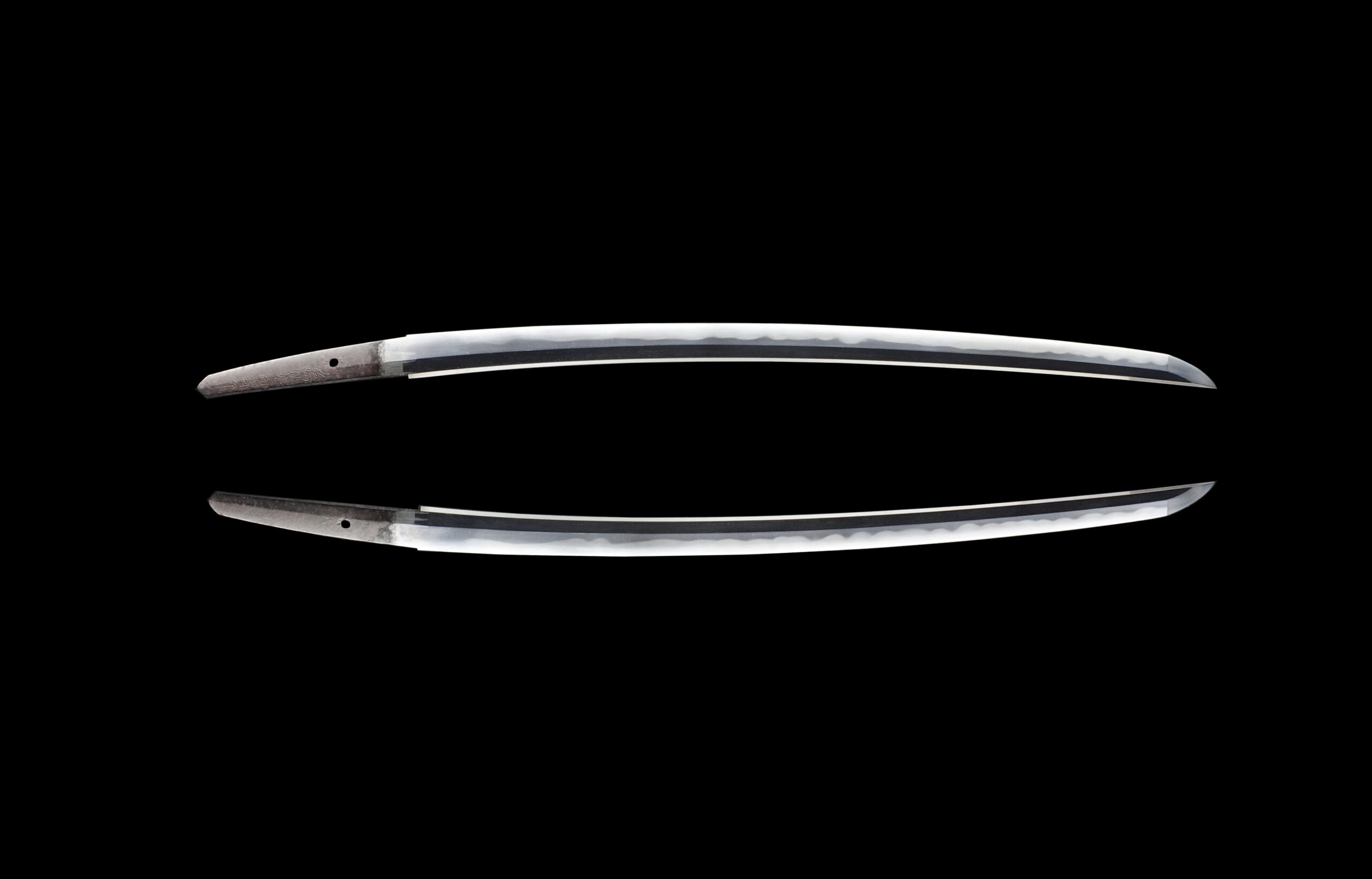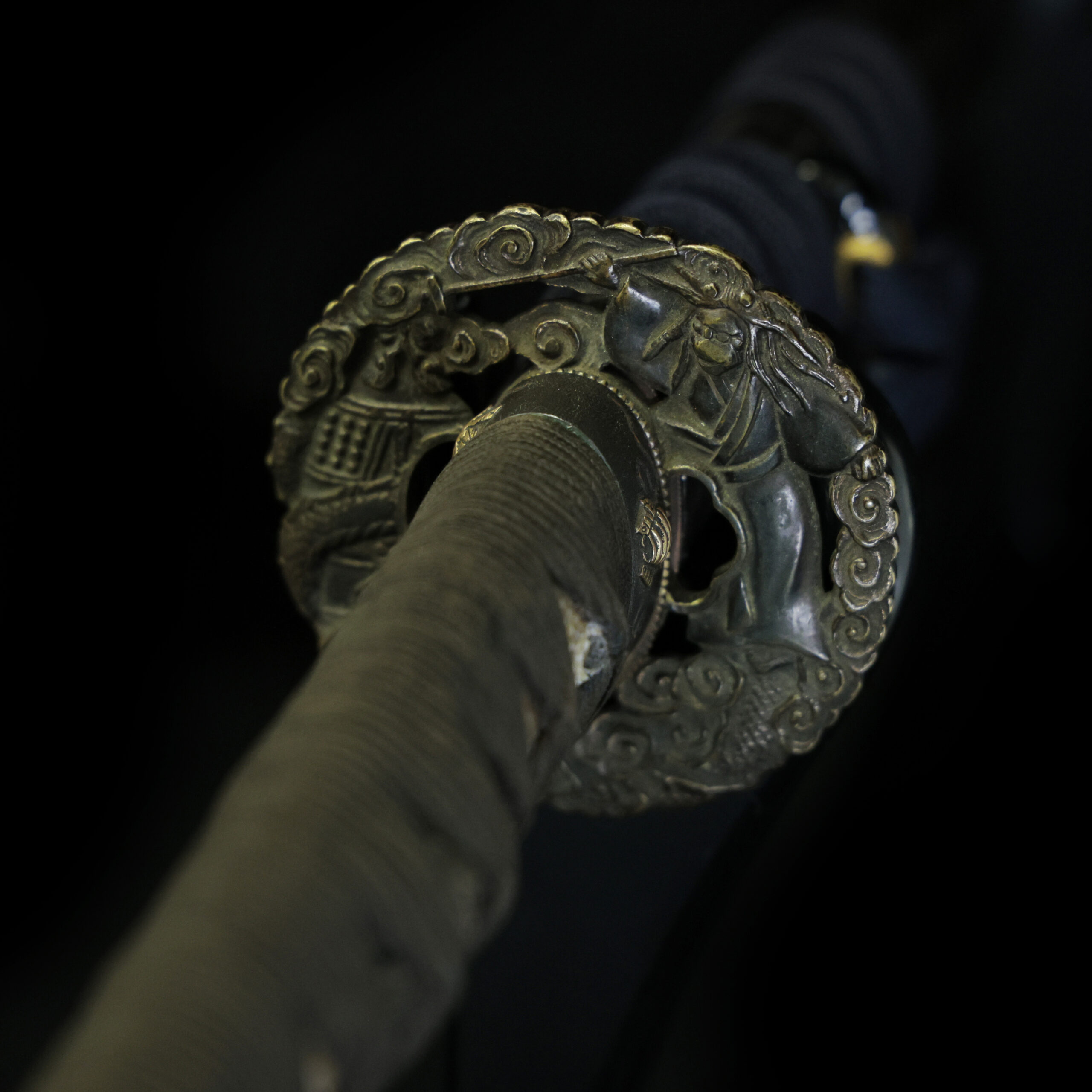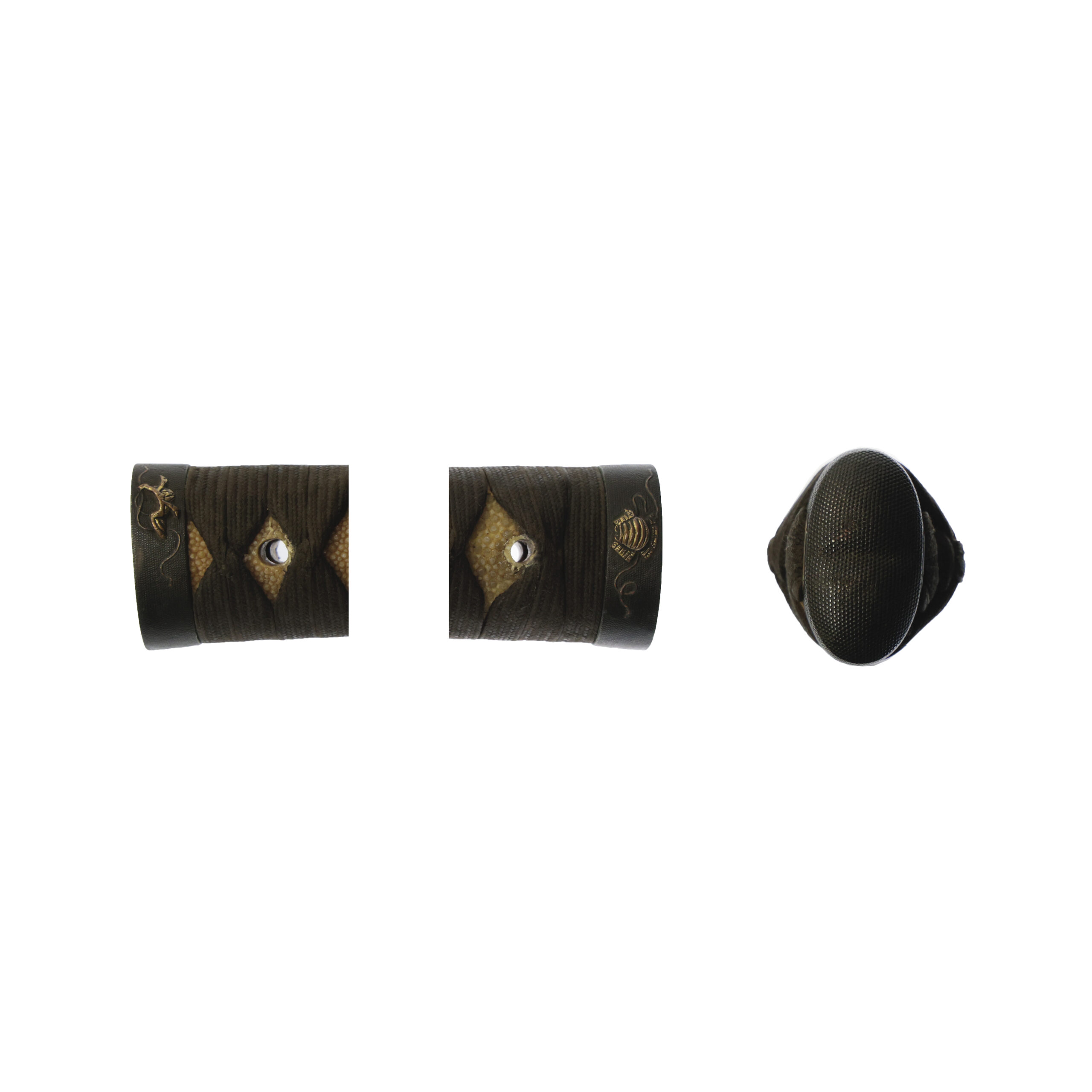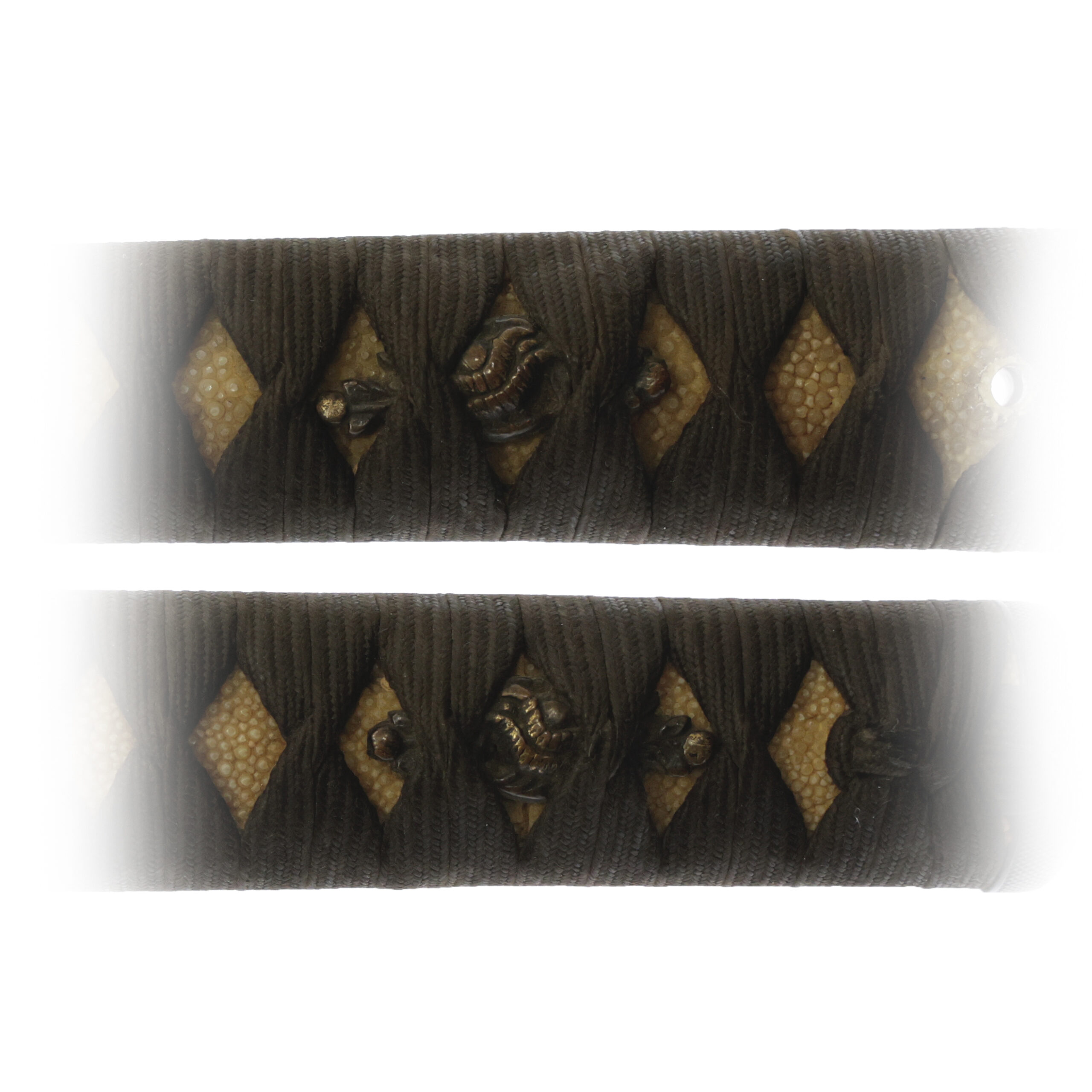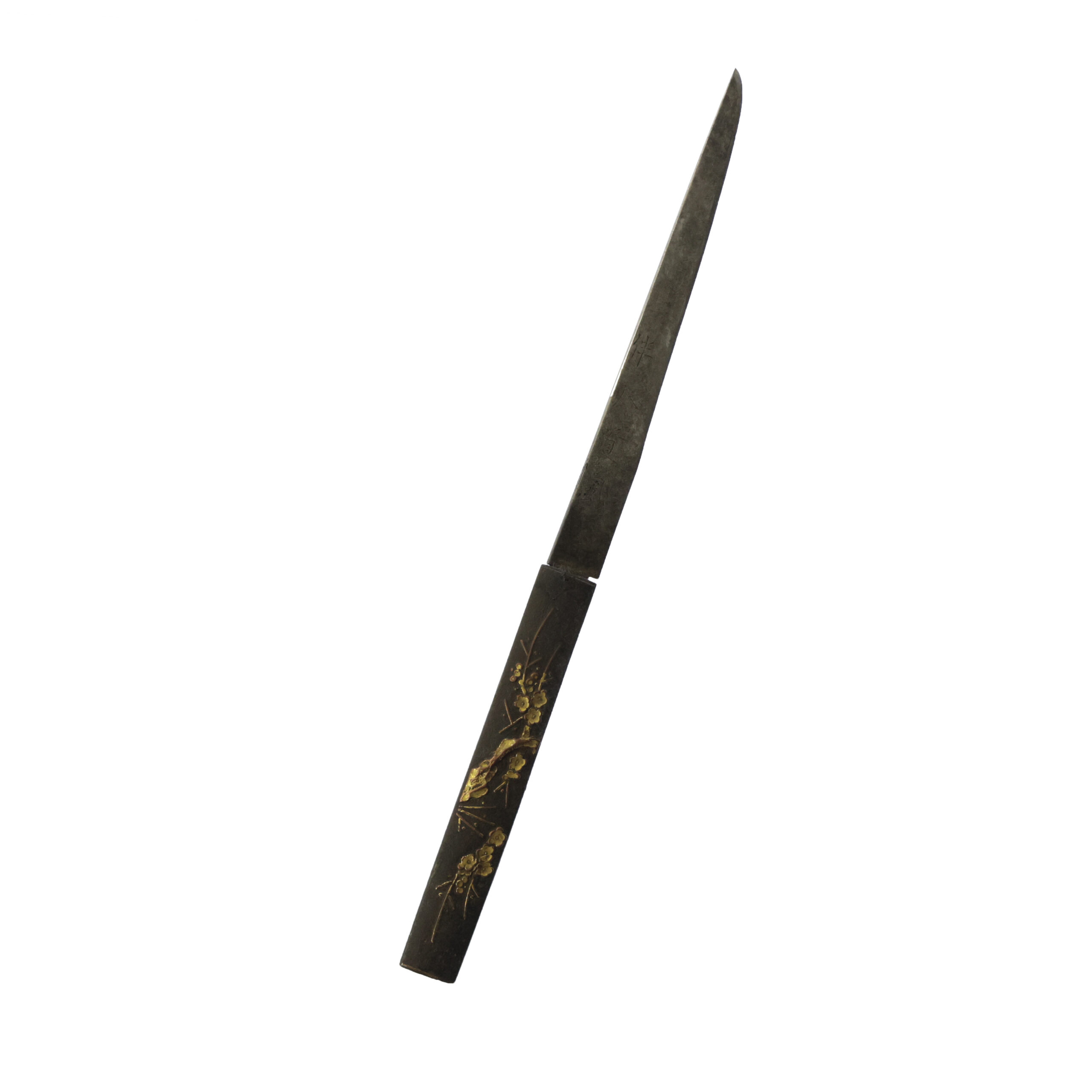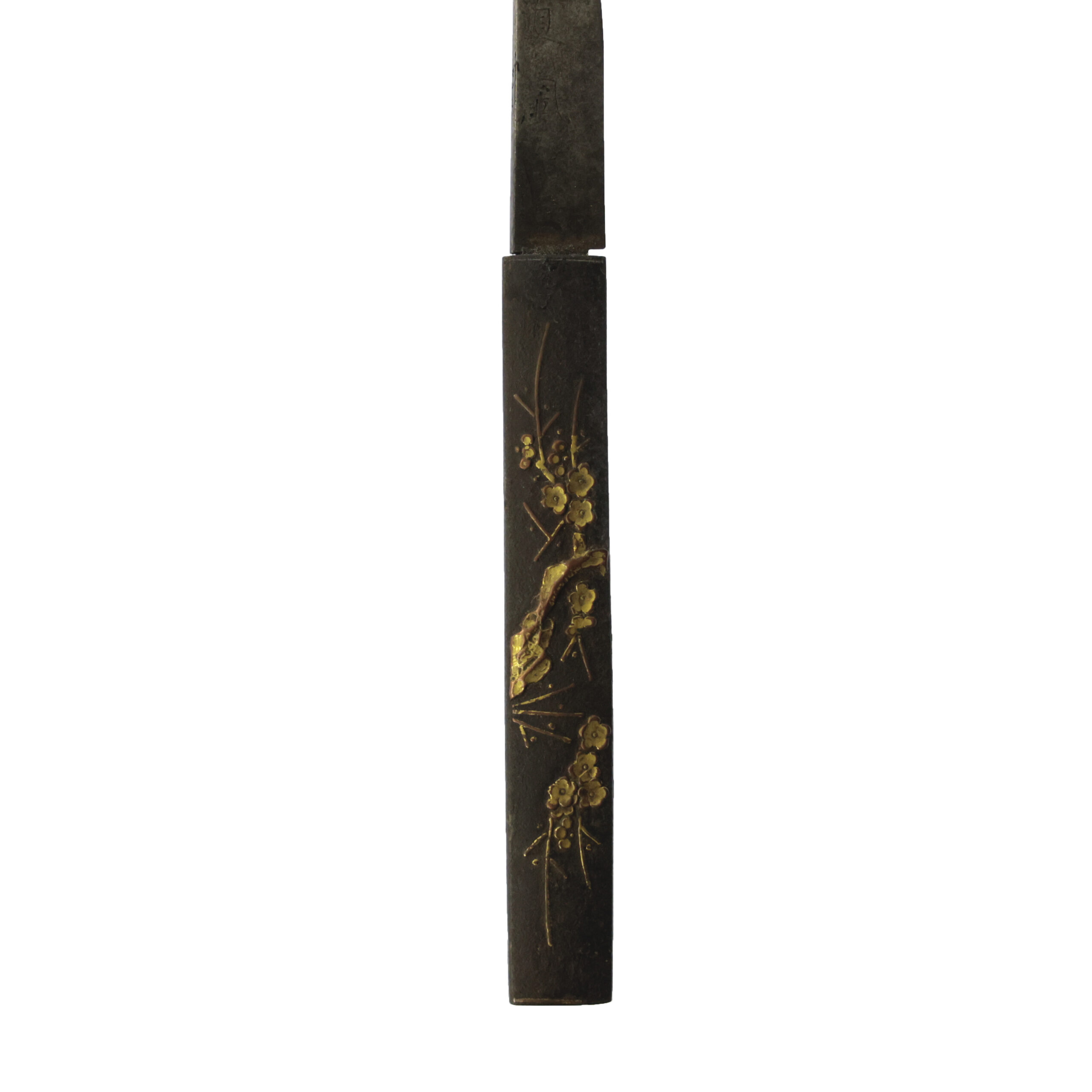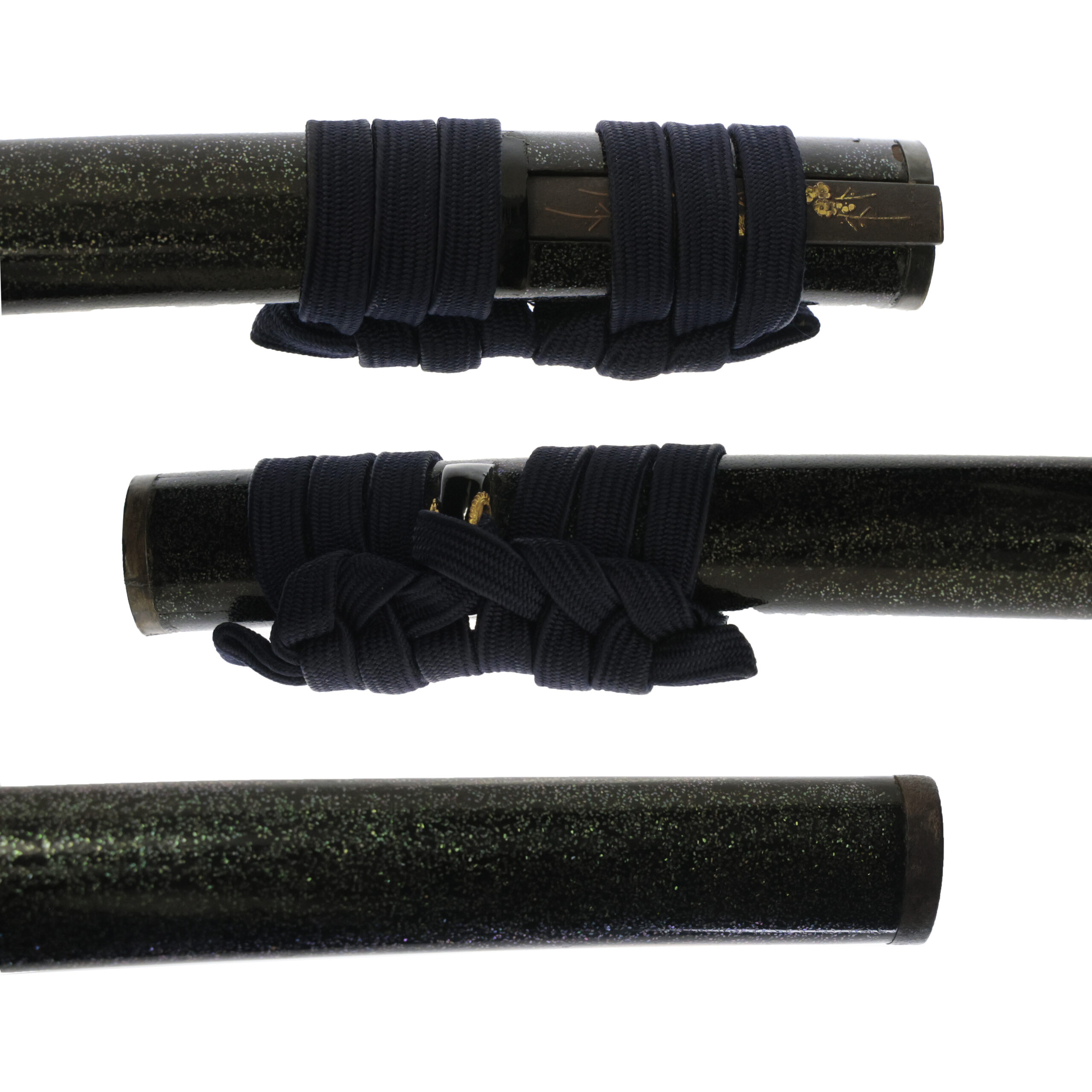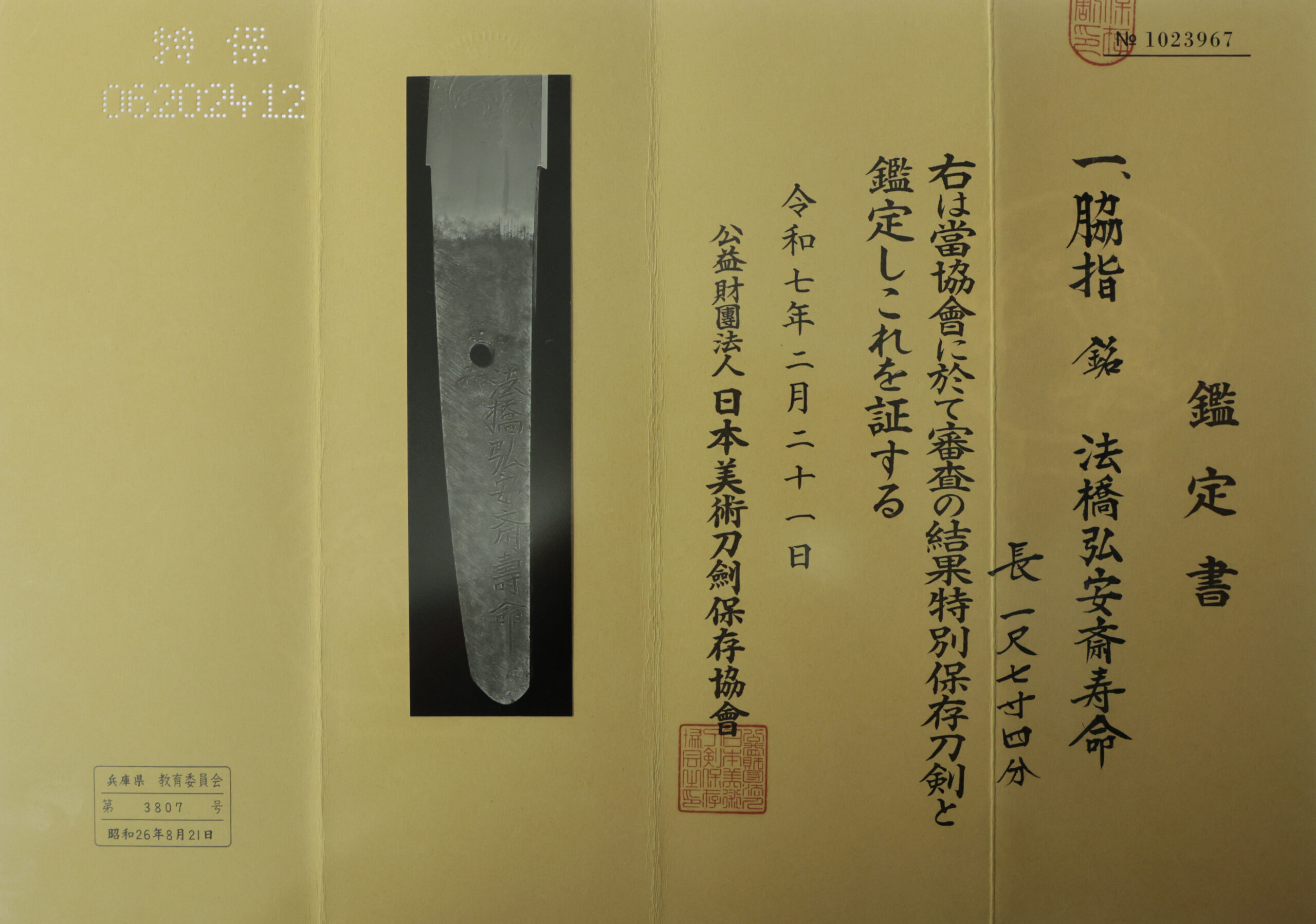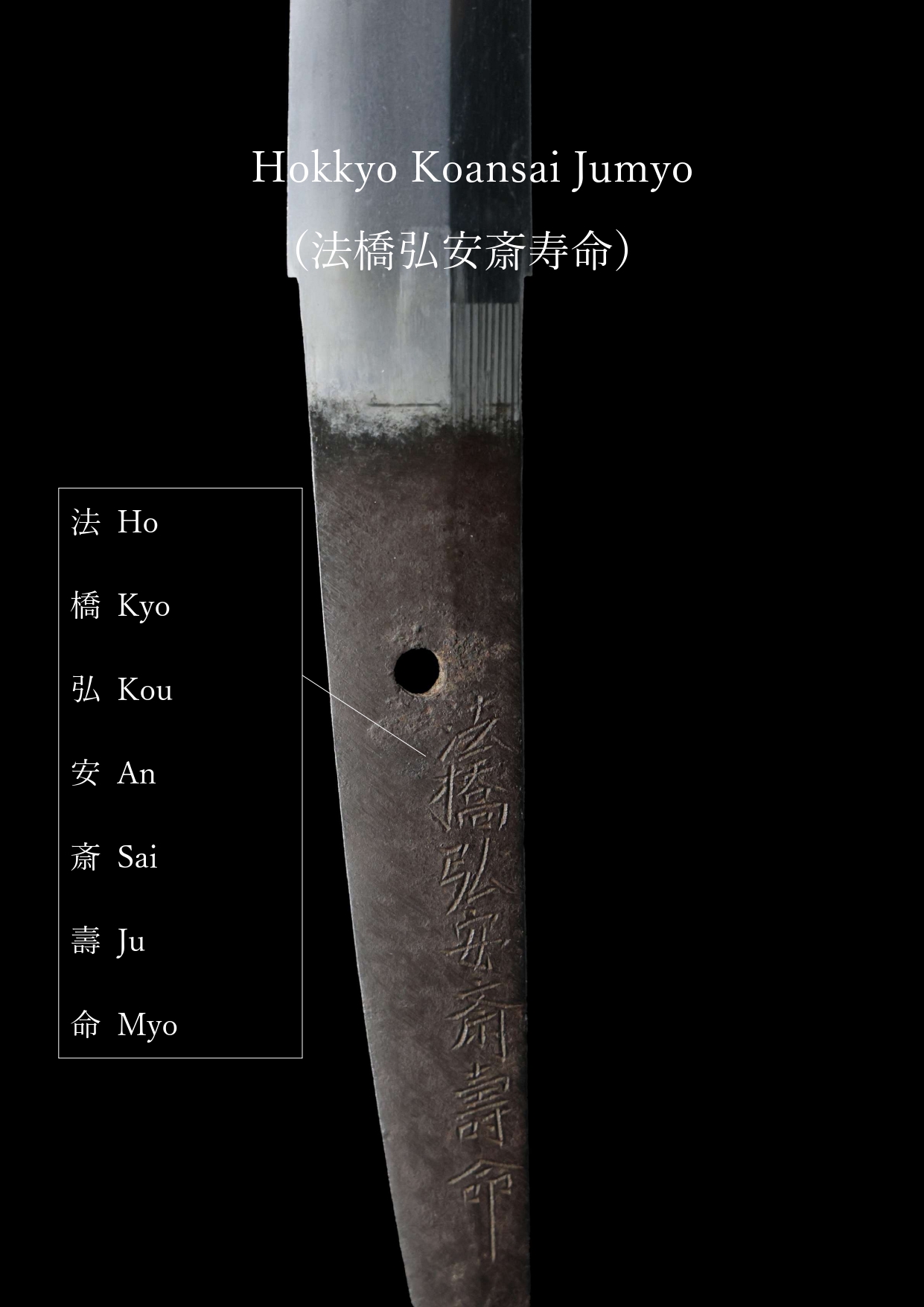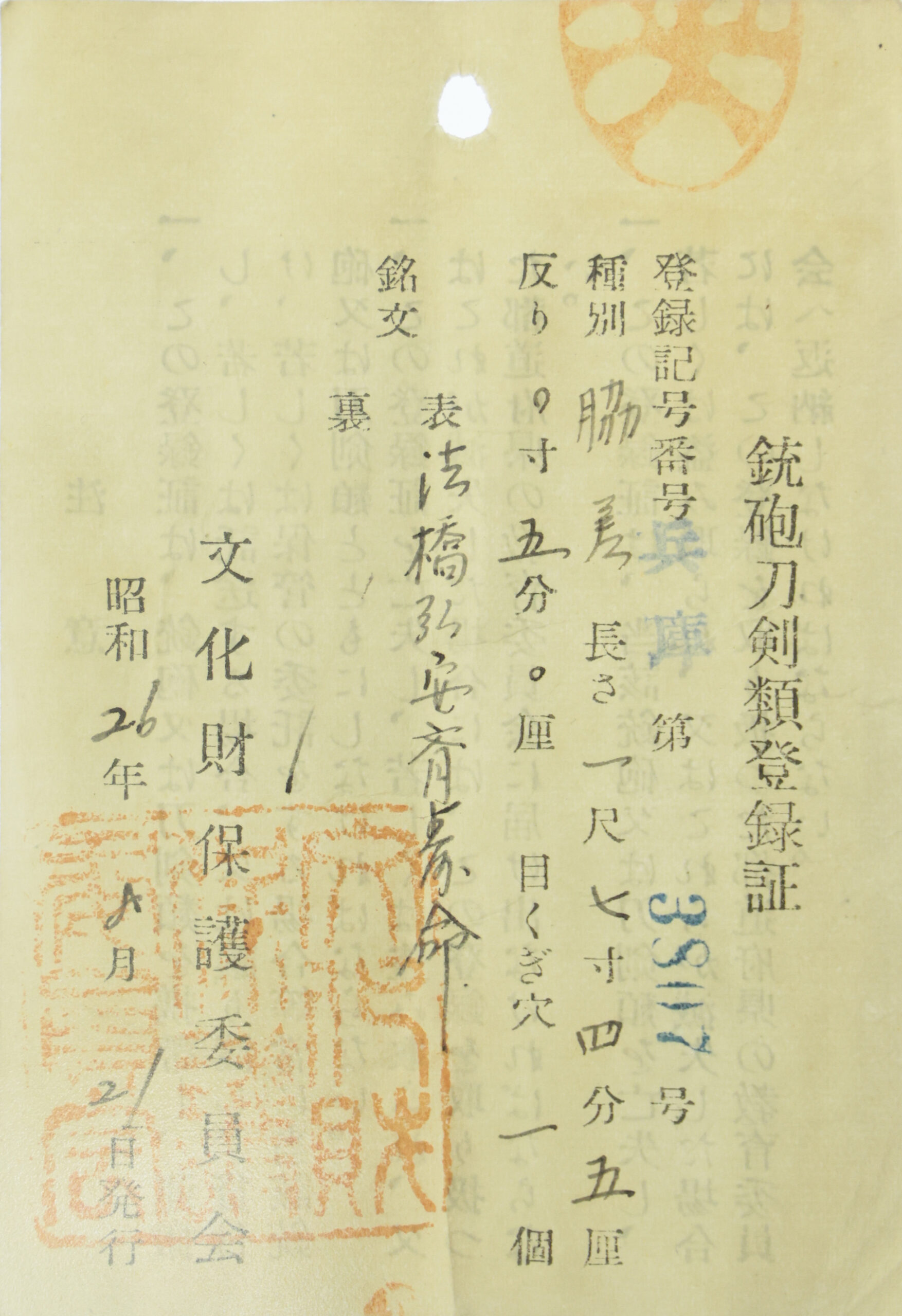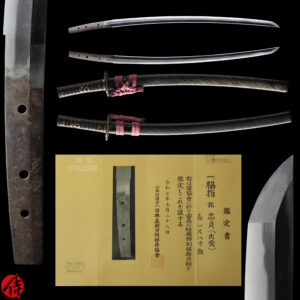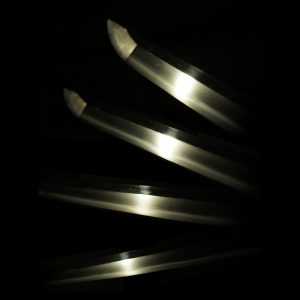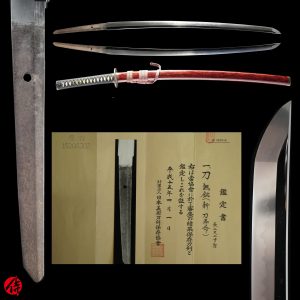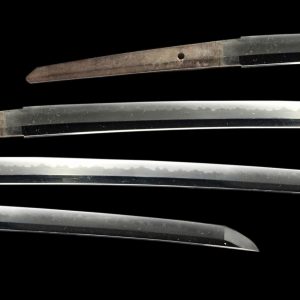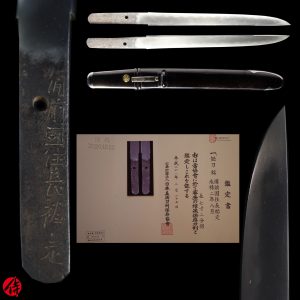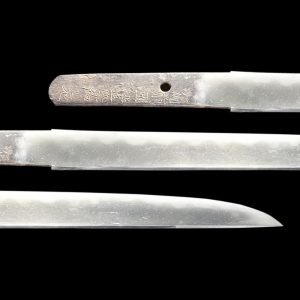Antique Japanese Sword Wakizashi Signed by the Hokkyo Koansai Jumyo with NBTHK Tokubetsu Hozon Certificate
【Description】
This sword was forged in the early Edo period by the swordsmith Jumyo (壽命, also read Toshinaga). The name Jumyō, which literally means “longevity” or “lifespan,” had been used by a line of swordsmiths originating in Mino province (present-day southern Gifu prefecture). Even during the Shintō period (early modern era), successors of this name remained active. Some established their forges in Shimizu (Ibigawa town, Gifu prefecture), while others moved to neighboring Owari province, working in Kiyosu and later in Nagoya. The auspicious name “Jumyō,” suggesting long life, was highly appreciated, and the school prospered for generations.
Among them, a smith who signed as Kōansai Jumyō stayed in Mino and was active around the Enpō era (1673–1681) in the early Edo period. His real name was Kondō Sōzaemon, and he is recorded to have died in 1703 (Genroku 16) at the remarkable age of eighty-four. True to his name, Jumyō indeed embodied longevity, both in reputation and in life.
The Jyumyo school has its origins in Yamato (Nara Pref.) and moved to Mino province in the Kamakura period (1185-). The tradition continued for centuries until the end of the Edo period (-1868). The school’s name, “JYUMYO,” means life span or longevity in Japanese. As its meaning is hopeful, the swords forged by the members of the Jyumyo school were appreciated and prized as a special gift among the SAMURAI society. We believe this blade was originally ordered by a high-class Samurai who lived near Mino province.
The MINO swordsmiths style, also known as MINO-DEN, basically has the TOGARI(Pointed shapes protruding from the Hamon )in a classic straight line and random temper line with some white Utsuri. MINO-DEN had its origin from YAMATO-DEN in the late KAMAKURA period(1280-1330). It flourished in the MUROMACHI period(1333-1573) and continued until the EDO period(1603-1868).


MINO-DEN especially prospered during Sengoku Jidai(Warring State period) due to the high demand for weapons. And the location of Mino province beat others. Akechi Mitsuhide controlled Mino province, Nobunaga Oda ruled Owari province, and Tokugawa Ieyasu was the lord of Suruga (Neighboring areas). There was high demand from those powerful feudal lords and their retainers. Furthermore, so many wars occurred between the Kanto region and the Kyoto area.
Mino is located in the middle, making feudal lords feel convenient to order swords from MINO-DEN. The blades forged in MINO provinces also had a reputation for their practical design and sharpness. Many feudal lords demanded swords forged in the Mino province. The tradition of excellent sword forging skills had been passed to the Edo period, and Mino no Kami Fujiwara Jyumyo is a good example.
It is appraised as a Tokubetsu Hozon Token (特別保存刀剣) issued by NBTHK (Nihon Bijutsu Touken Hozon Kyokai: 日本美術刀剣保存協会). This authentication paper was only given to authentic Japanese swords, especially well preserved and high quality with artistic value.
【Blade】
Cutting Edge Length (Nagasa):52.8 cm (20.7 inches)
Curvature (Sori): 1.51 cm (0.59 inches)

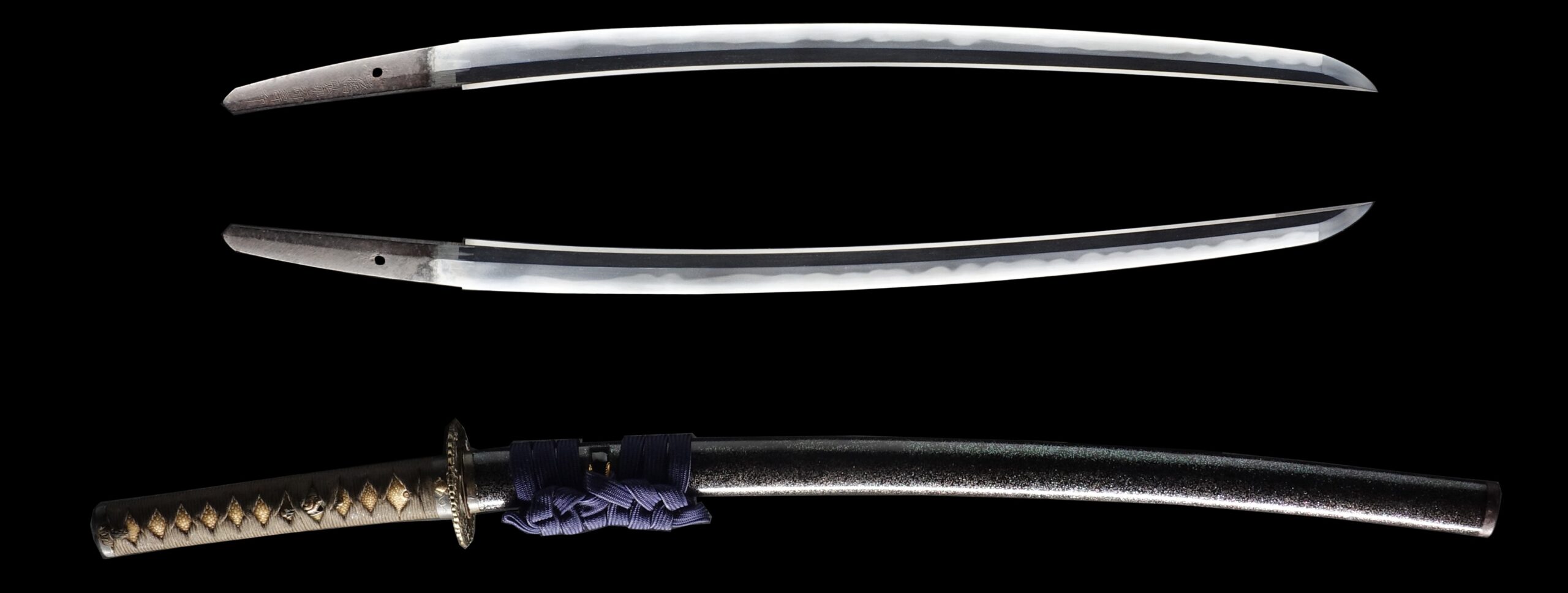
Hamon:
The crystalline structure which forms along the cutting edge of a blade as a result of the hardening process.
Jimon(Jihada):
visible steel surface pattern created by folding and hammering during forging process
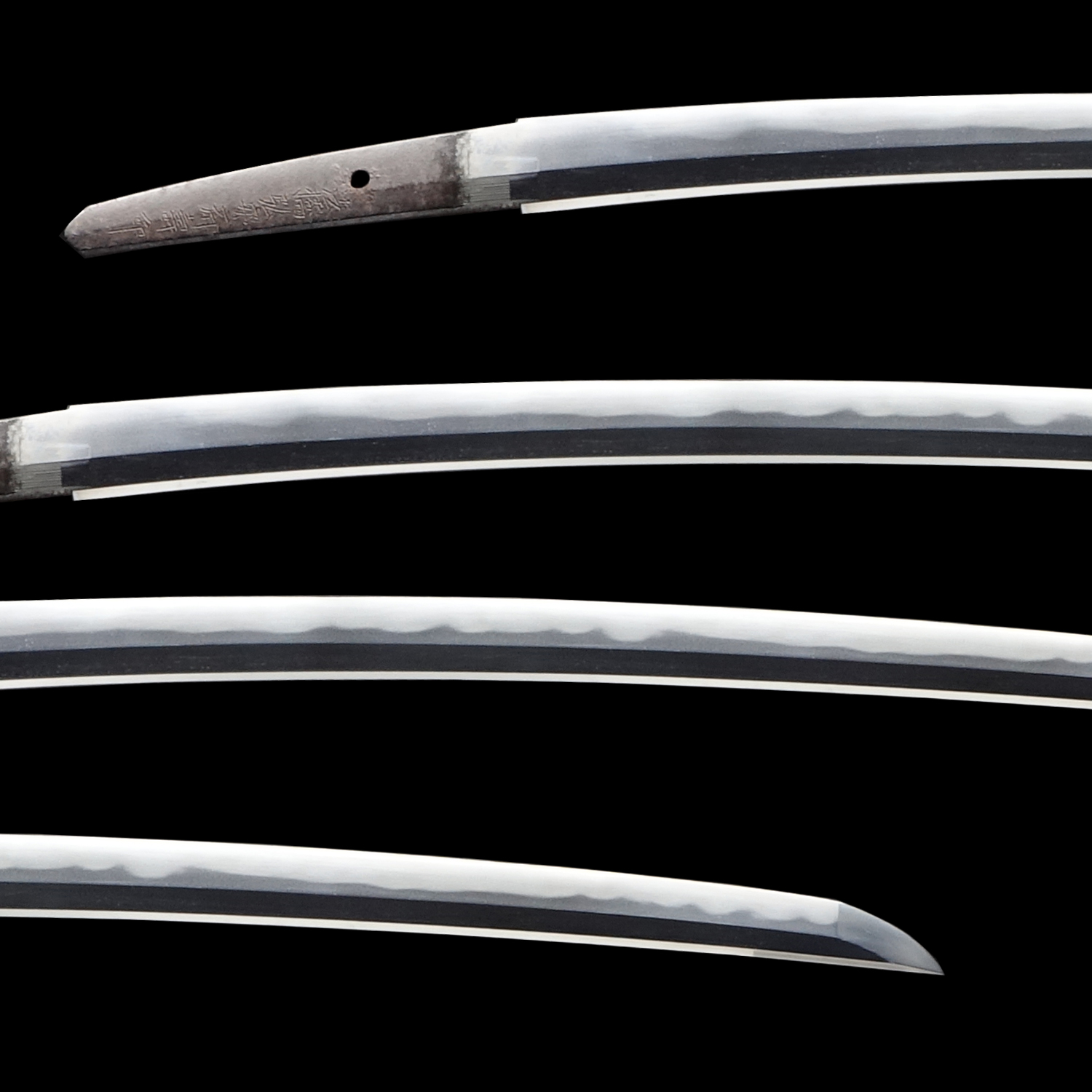
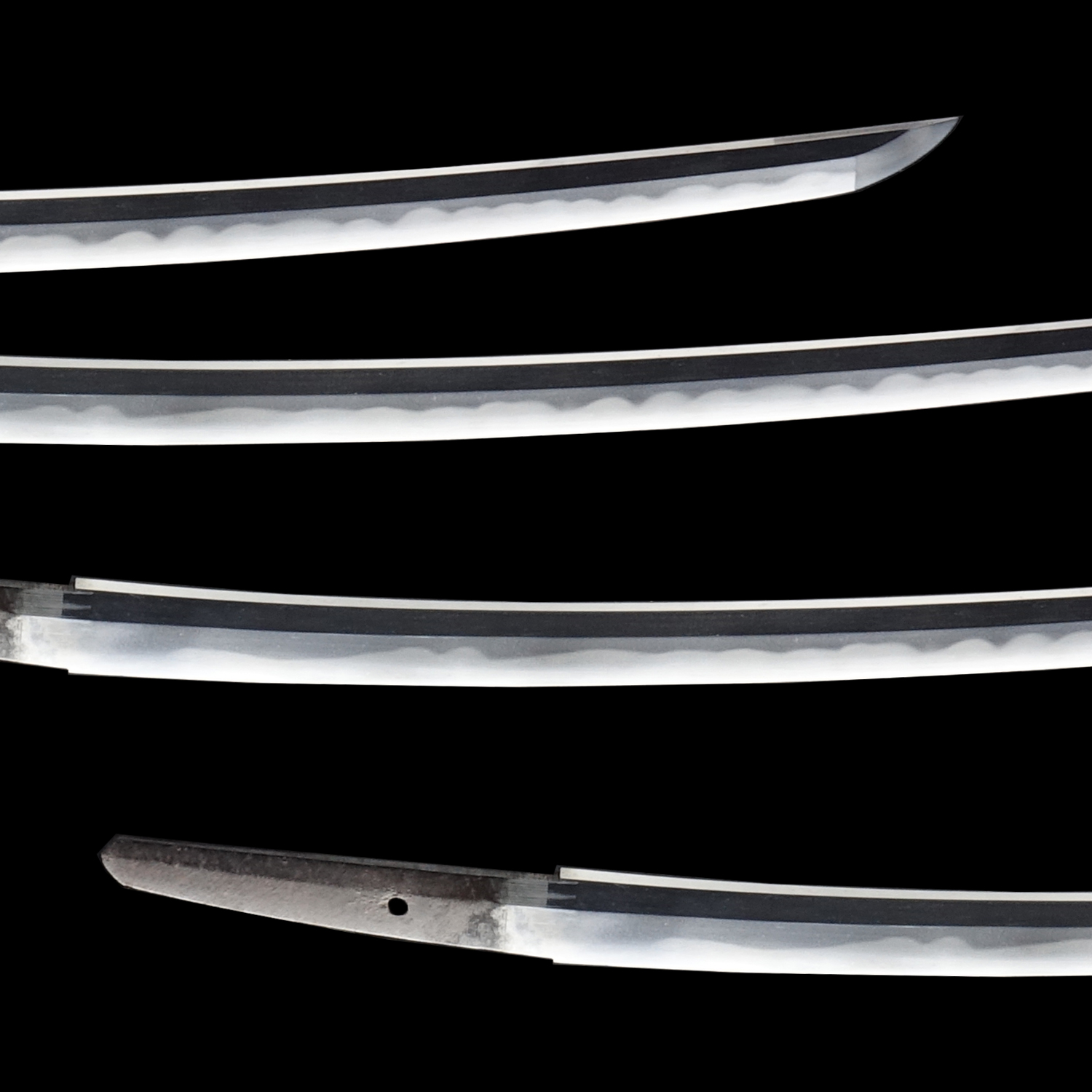

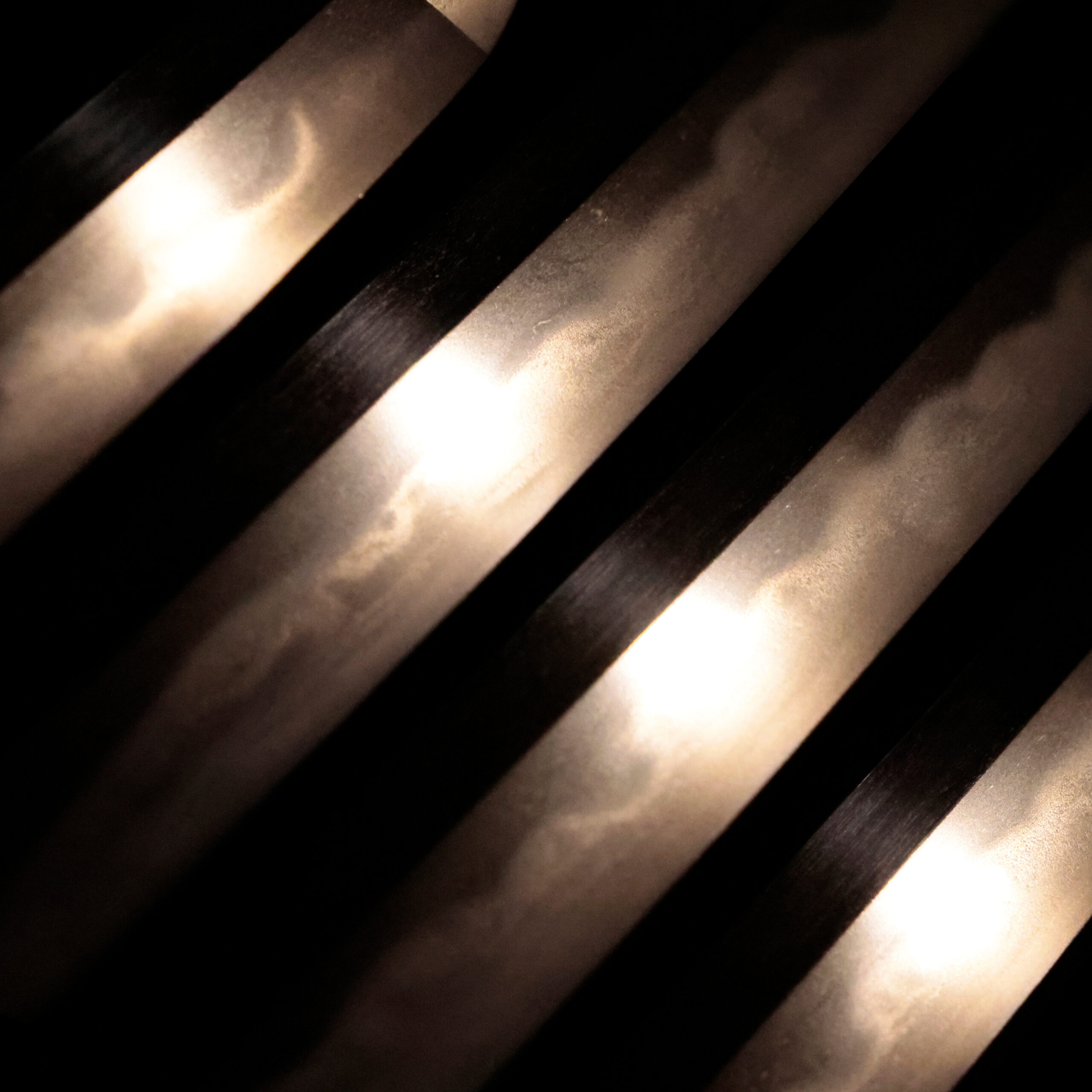
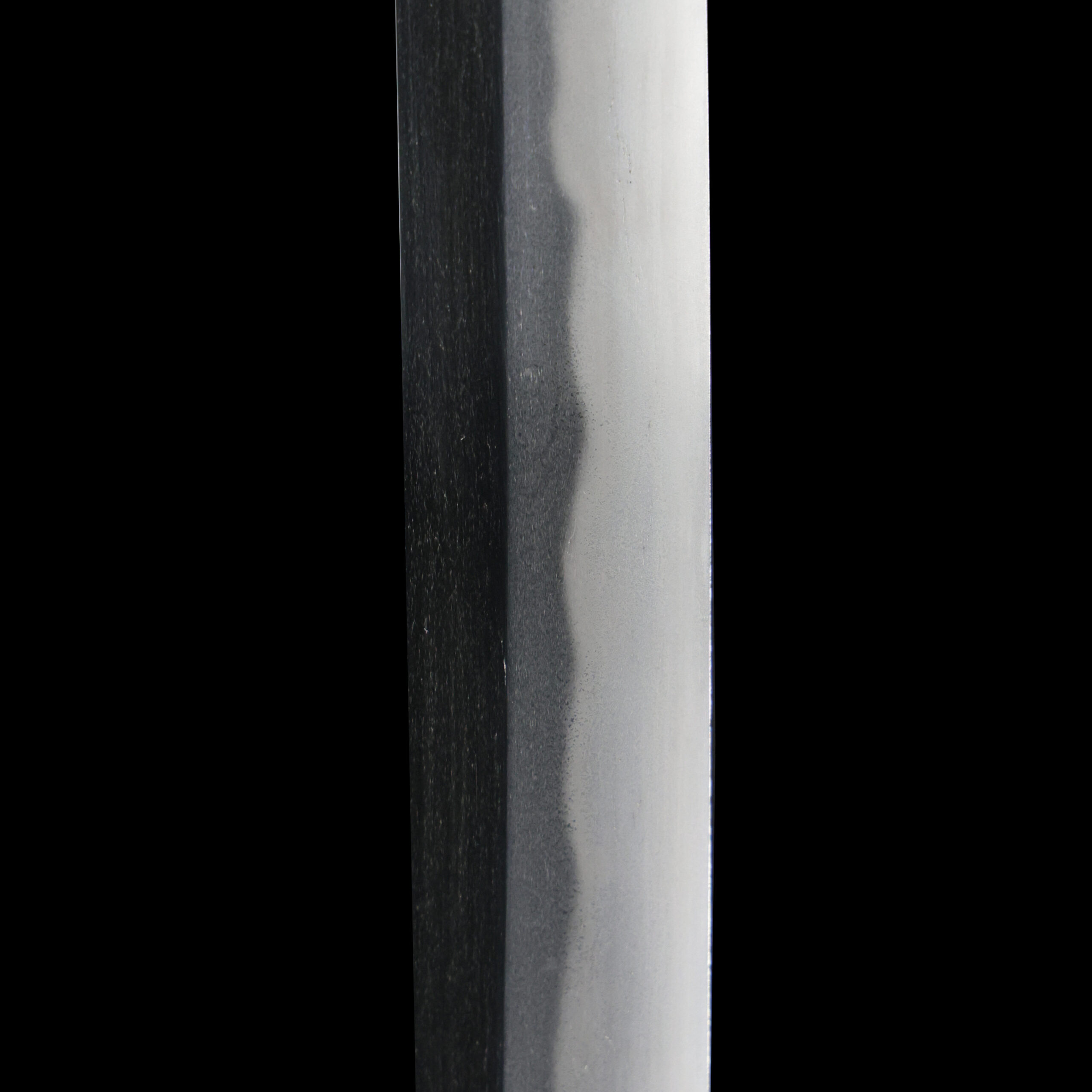

Kissaki: Kissaki is the tip of the Japanese sword.
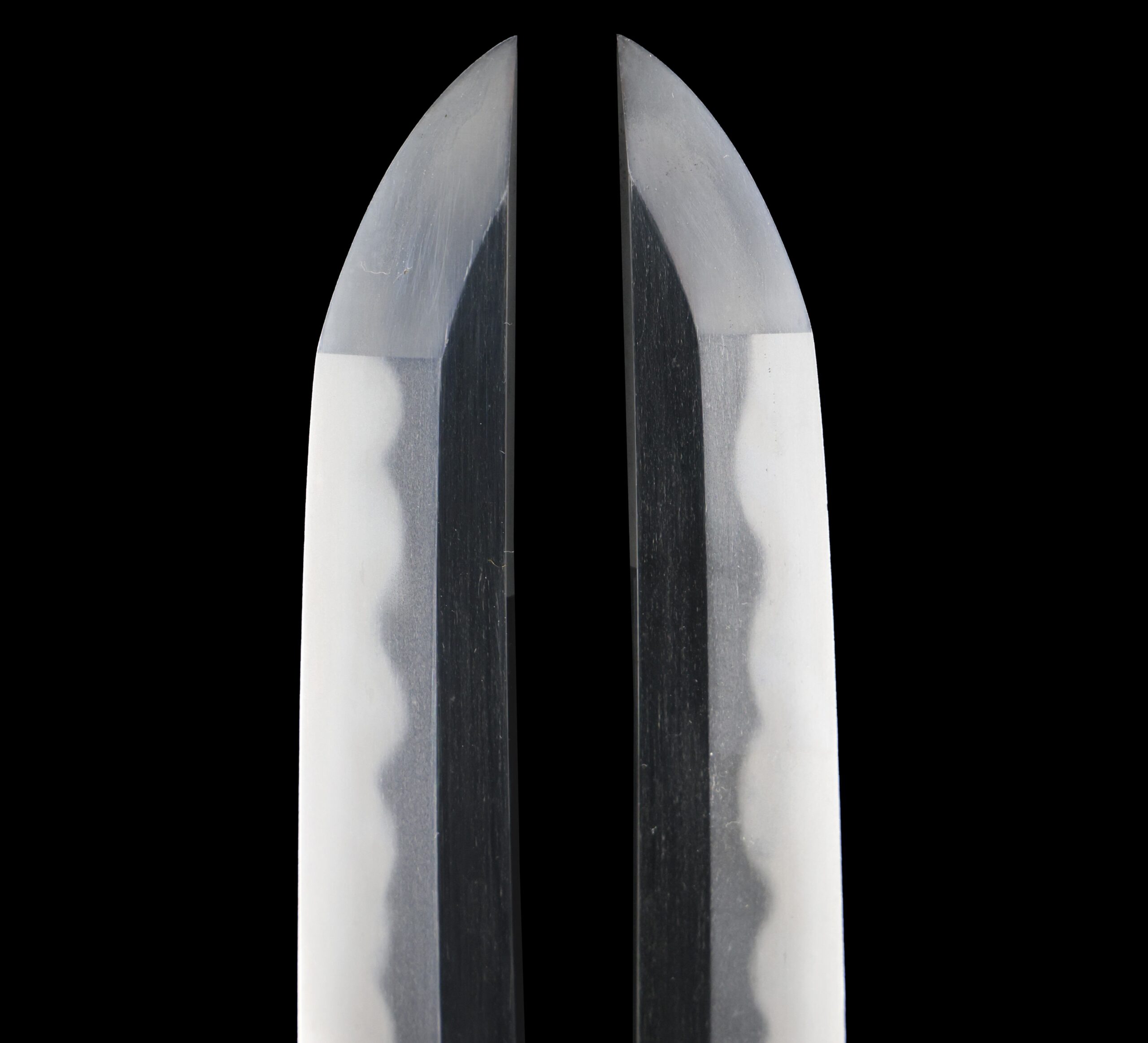
Nakago: Nakago is the tang of the Japanese sword.
Japanese swordsmiths left the black rust on the tang because it prevents red rust while the tang is in its handle. And the discoloration of the tang was created over time, and it is a great indicator for a Japanese sword specialist to estimate when the sword was forged.
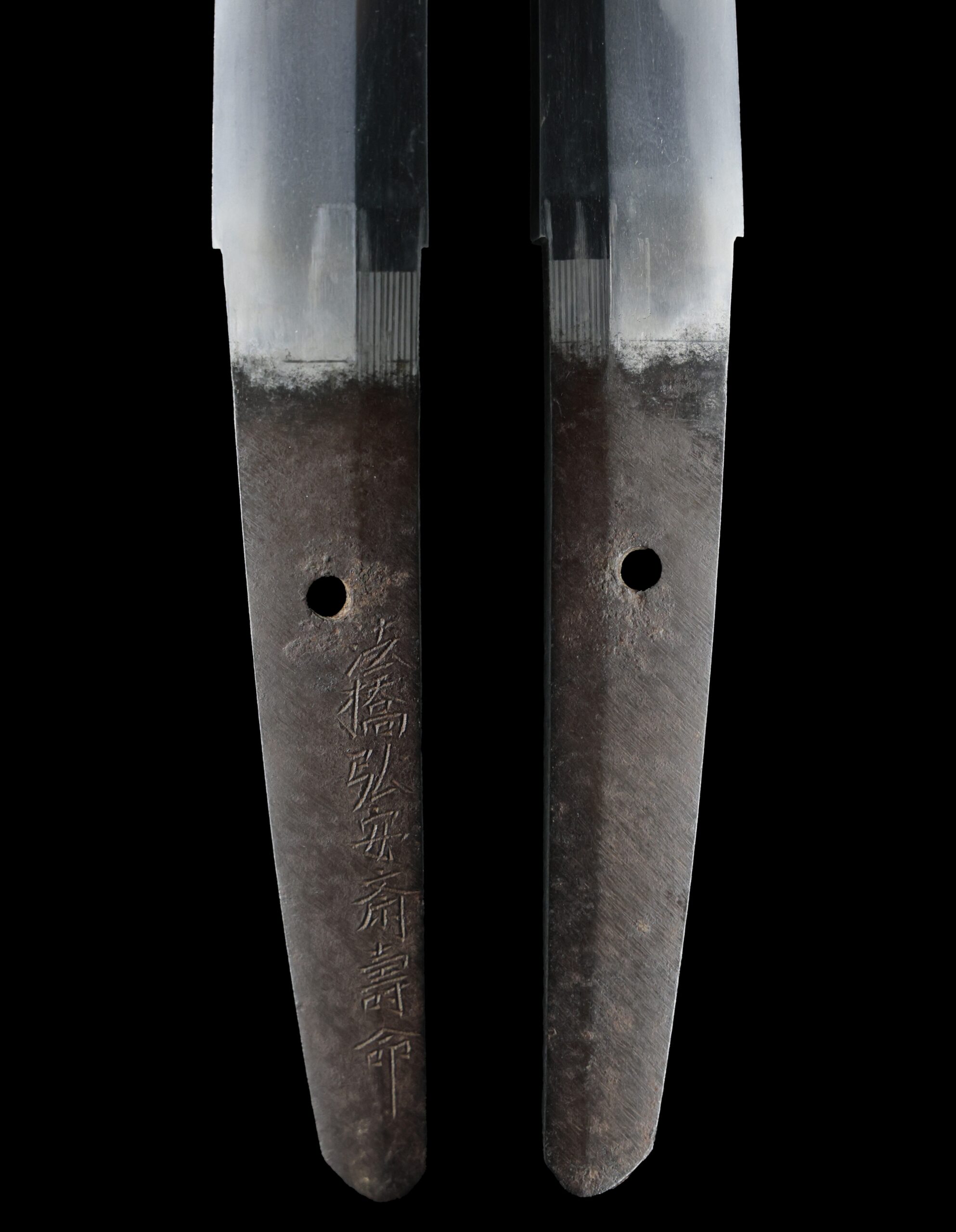
Koshirae:Koshirae is the mounting of the Japanese sword. There are several parts that consist of Koshirae such as Saya (Scabbard), Tsuka (Handle), Tsuba (Handguard).
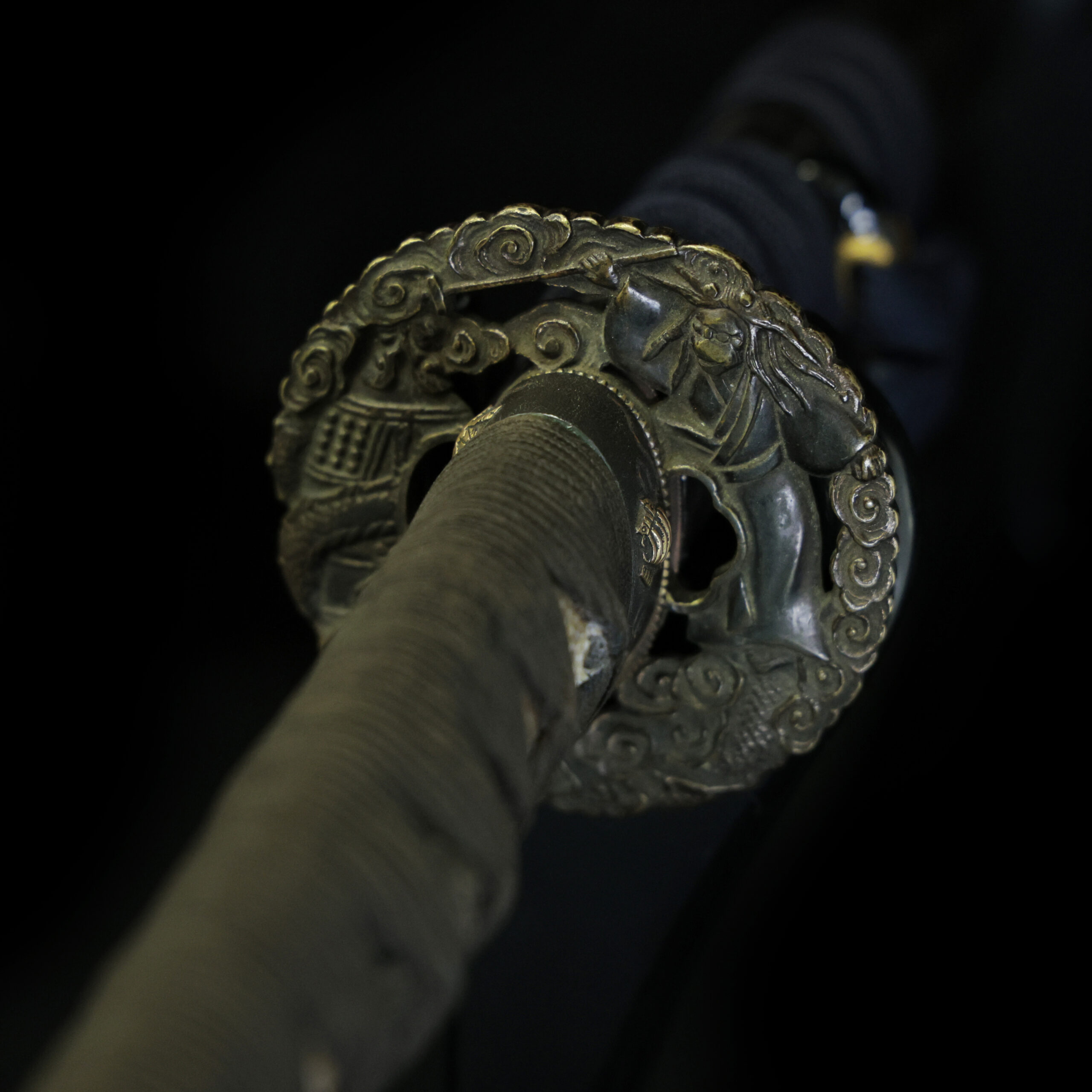
Fuchi-Kashira:A pair of matching sword fittings that cover the upper and bottom parts of its sword hilt.
This fuchi-kashira (hilt collar and pommel) is decorated with a helmet (兜, kabuto) and armor (鎧, yoroi) in fine gold inlay. Alongside the helmet, you can see cord-like elements, which reference an old Japanese proverb: “Win the battle, then tighten the cord of your helmet” (Katte kabuto no o wo shimeyo). This saying conveys the lesson that one should not become careless after achieving success, but instead remain cautious and disciplined, even in victory.
In addition, the background of this piece features the Nanako-ji (魚々子地) technique, a traditional decorative method where countless tiny, evenly spaced dots are hammered into the metal surface. This creates a refined texture resembling fish eggs, which enhances the brilliance of the gold inlay and adds a sense of elegance and formality to the overall design.
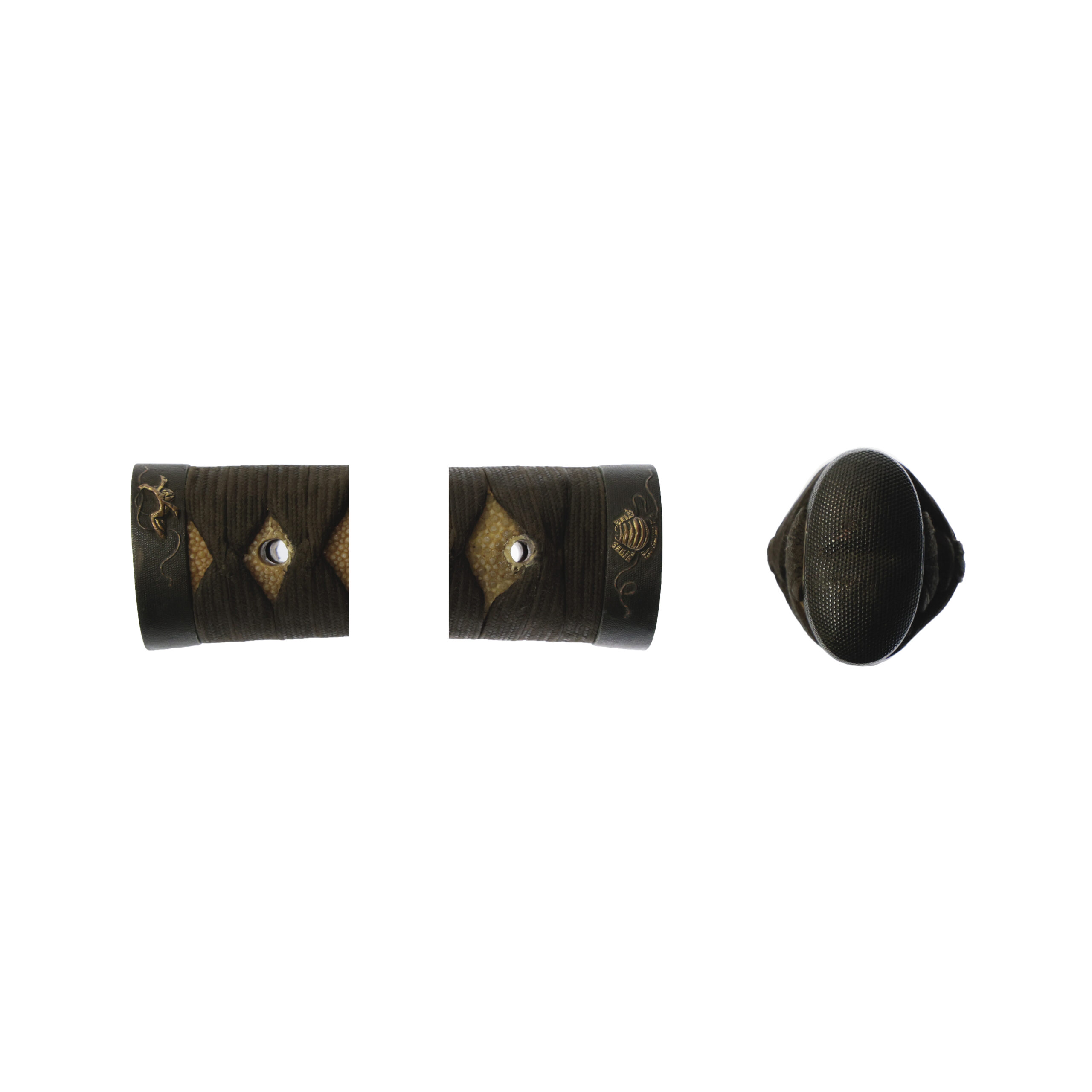
Tsuka and Menuki: Tsuka is the handle of the Japanese sword and Menuki is its decoration.
The motif of this menuki appears to be a conch shell, known as “Horagai” (法螺貝). The conch shell originates from Hinduism and is closely linked to the teachings of Buddha. Historically, Yamabushi (mountain ascetics) used it to convey sermons. The conch was brought to Japan around 806 AD by monks like Kukai (空海) and Saicho (最澄), who returned from Tang China, with five of the eight bringing conch shells. Its sound represents the teachings of Buddha, making it a sacred instrument in Japanese esoteric Buddhism.
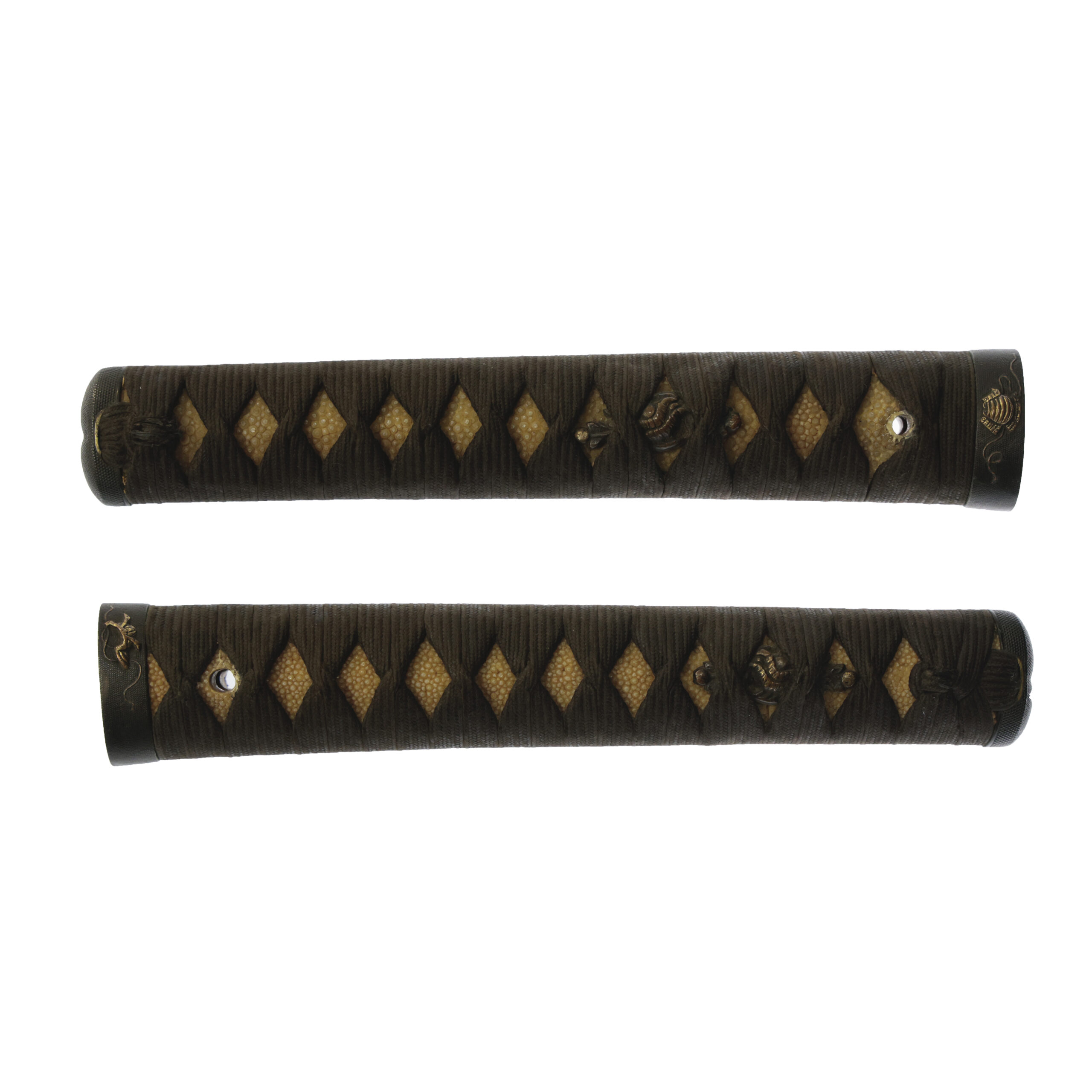
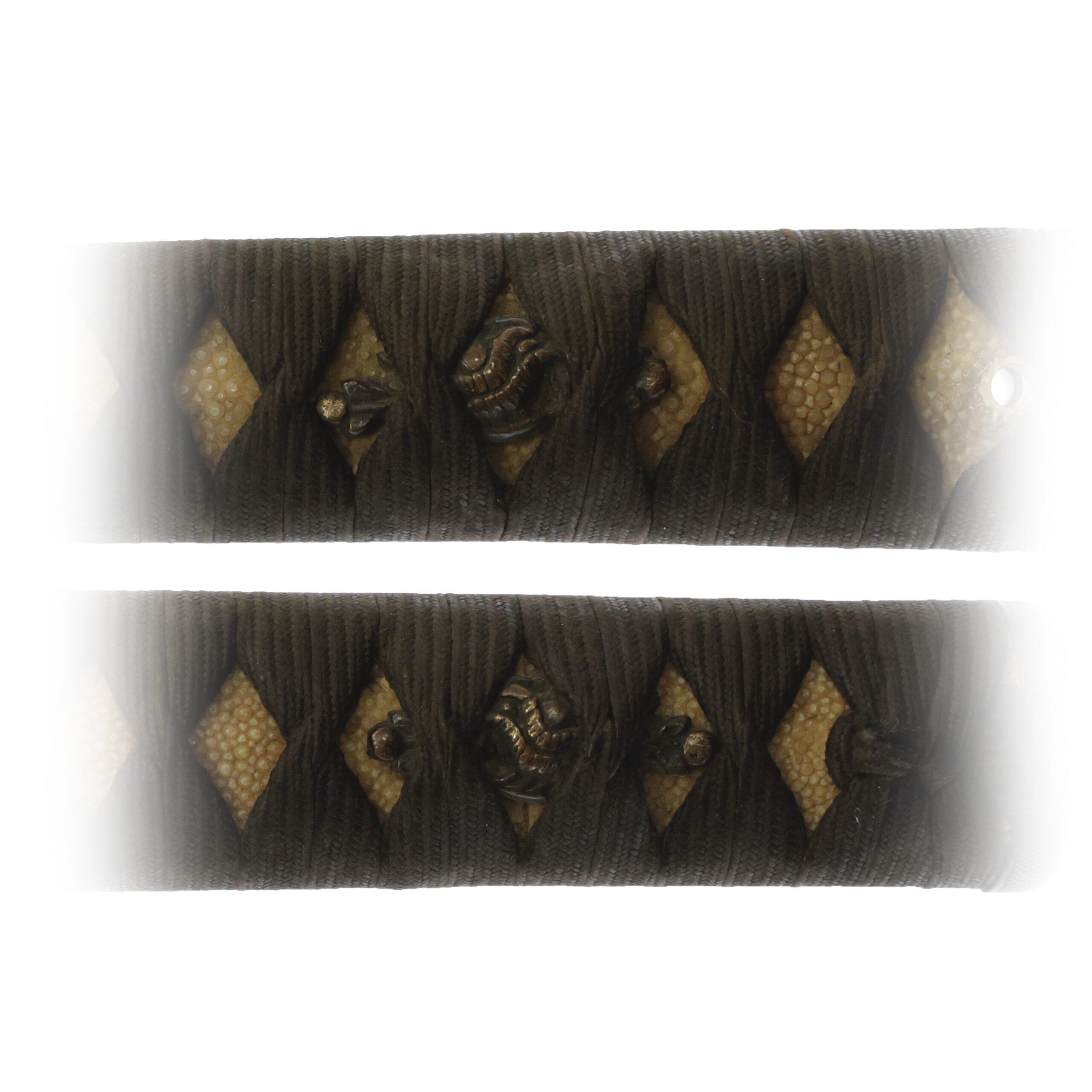
Tsuba and Habaki: Tsuba is the handguard for the Japanese Sword and Habaki is the equipment to make the blade not touch its scabbard inside. It prevents the blade from getting rusty and chipped.
The design of this tsuba shows a figure on the right-hand side holding a staff, seemingly riding on the back of a dragon. This motif is likely an “Shōsen-zu” (昇仙図, Ascending Immortal Scene). In East Asian tradition, the dragon is a sacred creature that symbolizes divine power, authority, and a connection between heaven and earth. The figure is interpreted as a Taoist immortal (仙人, sennin), ascending to the heavens on a dragon. Such imagery represents spiritual transcendence, longevity, and the attainment of enlightenment or supernatural powers. For the samurai, incorporating this kind of design into sword fittings expressed not only an admiration for divine protection but also a wish for wisdom, strength, and an auspicious life.
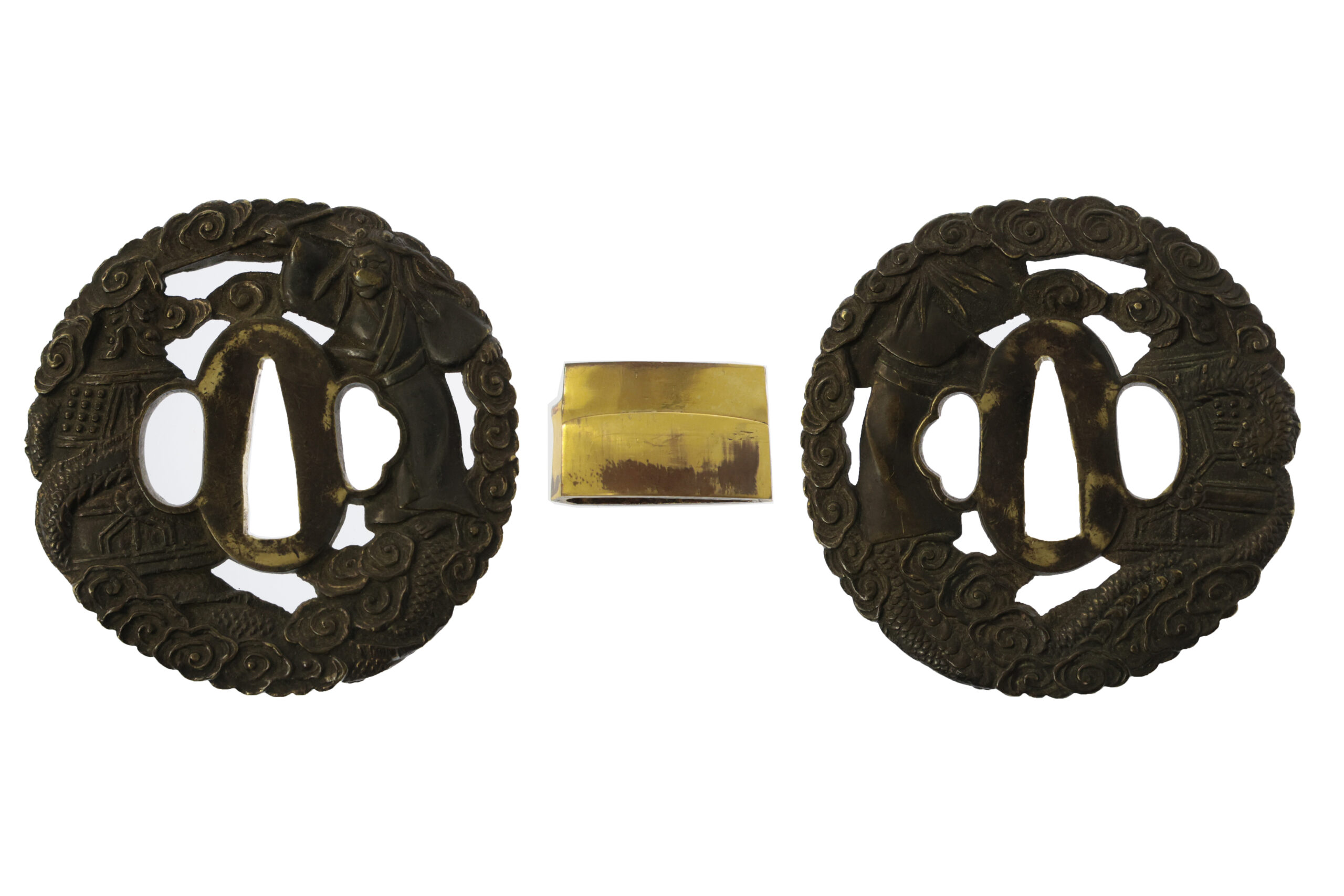
Kozuka:Kozuka is a small knife stored in Kozuka Hitsu(groove of the sheath of the Japanese sword).
The theme of this kozuka is the plum tree (梅, ume). In Japanese culture, the plum tree is one of the most beloved motifs, symbolizing resilience, renewal, and the coming of spring. Plum blossoms are admired as the first flowers to bloom in late winter, often blossoming even in snow, which makes them a metaphor for perseverance and vitality.

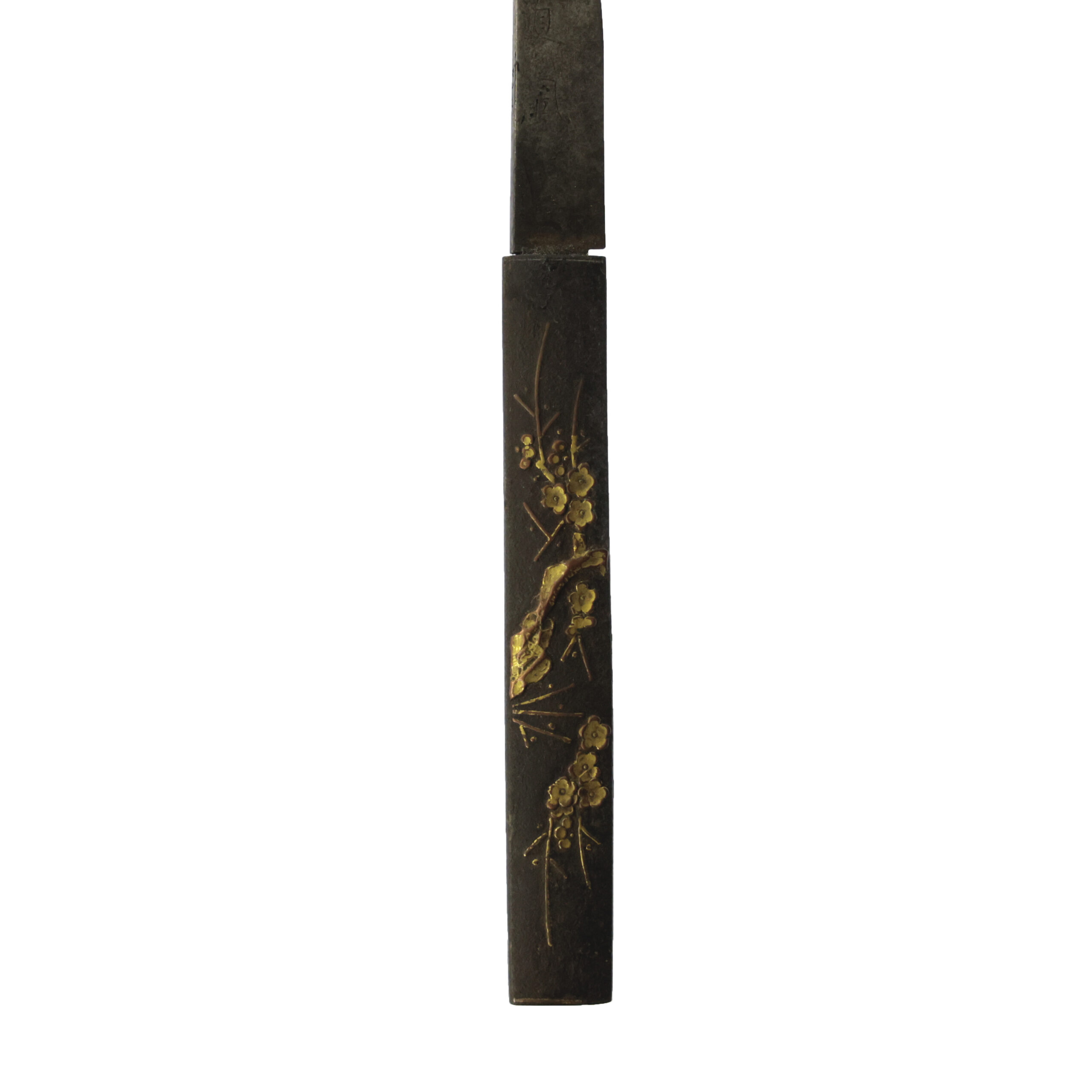
Saya: Saya is the scabbard for the Japanese sword.
This saya features raden(螺鈿) craftsmanship, a traditional Japanese decorative technique. Raden involves inlaying or embedding thin pieces of shell, such as mother-of-pearl or abalone, into lacquer or other materials. The shimmering, iridescent quality of the shells creates a striking visual effect, reflecting light in a play of colors that range from soft pastels to vivid hues. This technique has been used in Japan for centuries, adorning everything from furniture to accessories and weapons, showcasing the skill and artistry of the craftsman.
*Please kindly note that the scabbard of the katana has a small crack with minor lacquer loss.
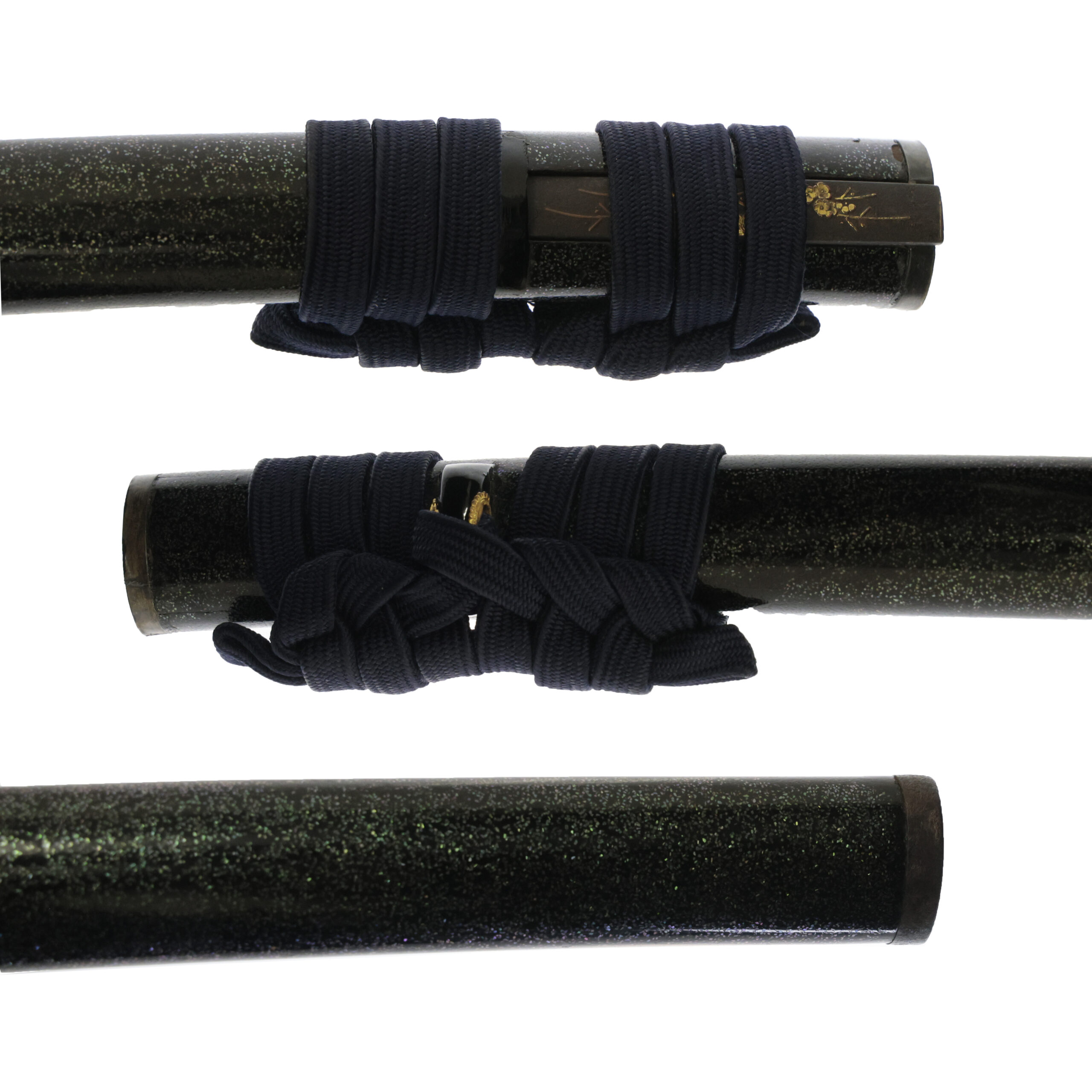
Authentication Paper: NBTHK TOKUBETSU Hozon Certificate for the blade (No. 1023967)
NBTHK, also known as Nihon Bijutsu Touken Hozon Kyokai (the Society for the Preservation of the Japan Art Sword), is one of the oldest Japanese sword appraising organizations in modern-day Japan. They authenticated the blade on February 21st in the 7h year of Reiwa (2025). They appraised it as Tokubetsu Hozon Touken, the blade especially worth preserving for Japanese society. The purchaser will receive this original certificate as well. We can also translate what is written into English and make a PDF file for your record if you request.
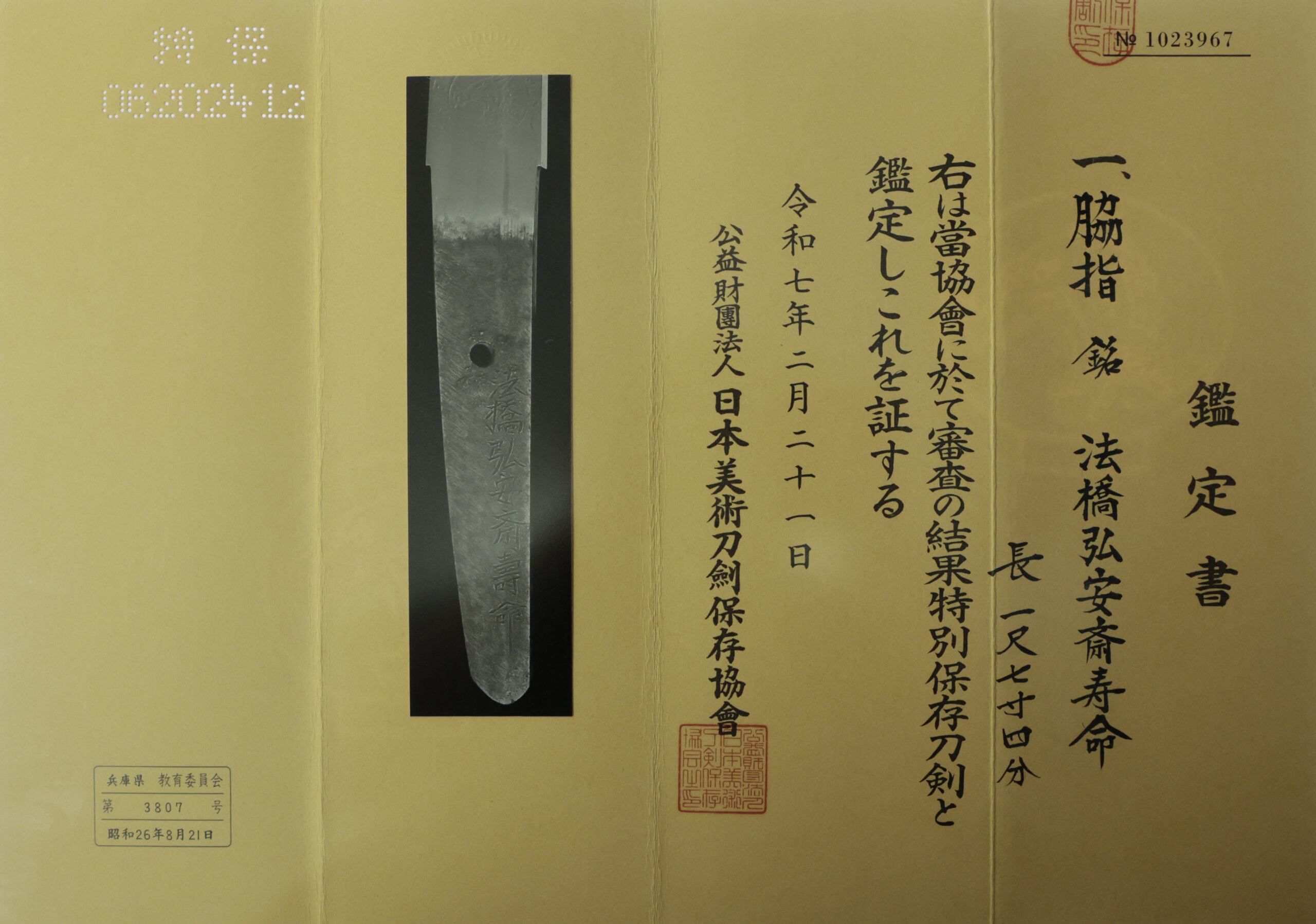
Registration Number: Hyogo 3807
The Board of Education in Hyogo prefecture issued a registration paper for this sword . It is called Jyu Hou Token Rui Tourokusho (銃砲刀剣類登録証). Bunkacho (The Agency for Cultural Affairs) acknowledges a Japanese sword with this paper as a work of art.
The sword needs to be traditionally hand-forged and made of Tamahagane carbon steel to be registered in the system. With this paper, its owner in Japan can legally own an authentic Japanese sword. Based on this registration number, we will apply for its export permit.
This paper will need to be returned to the board of education when the sword is being shipped abroad, but you can receive a copy of it. An English translation of this registration paper is available on request.
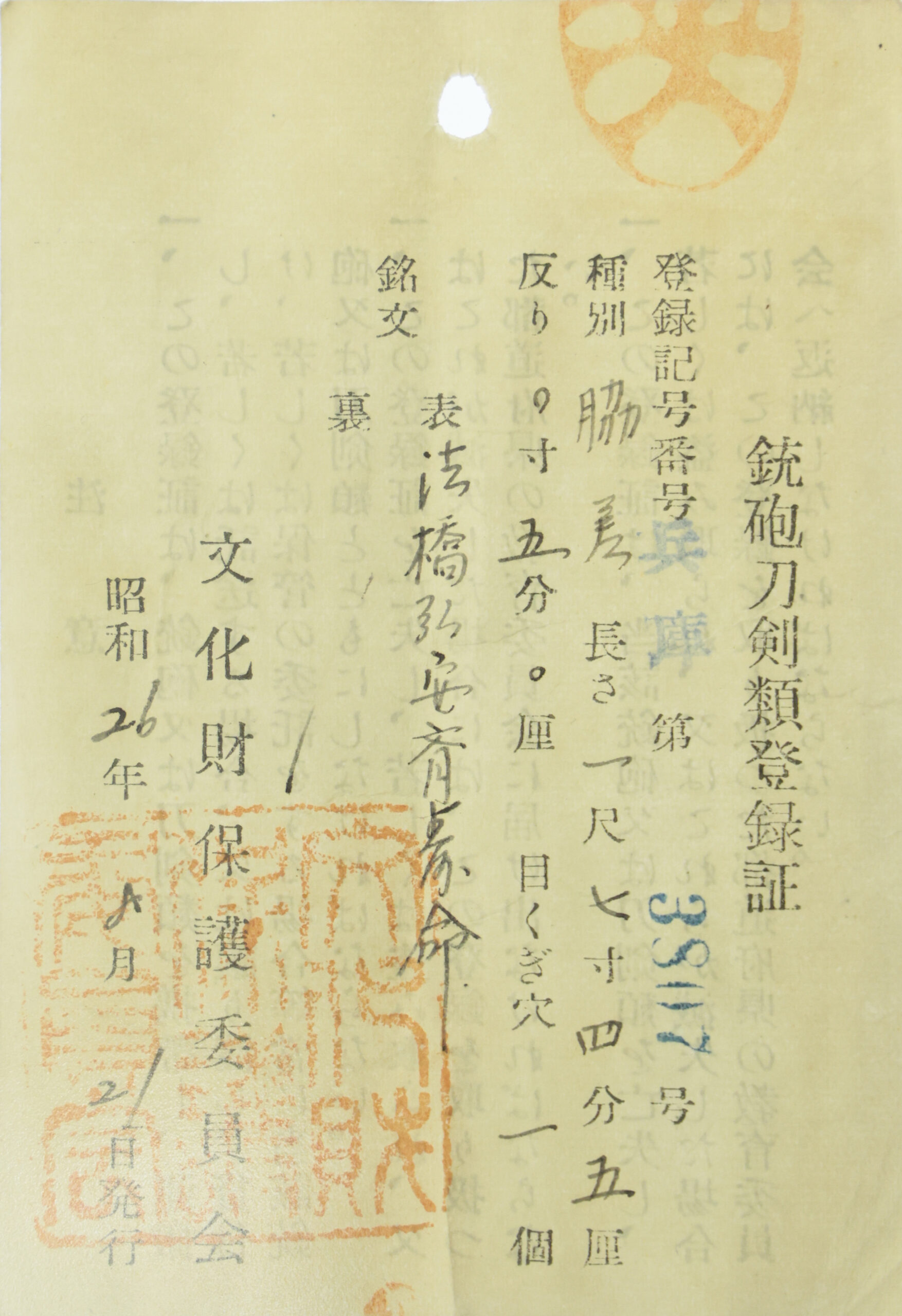
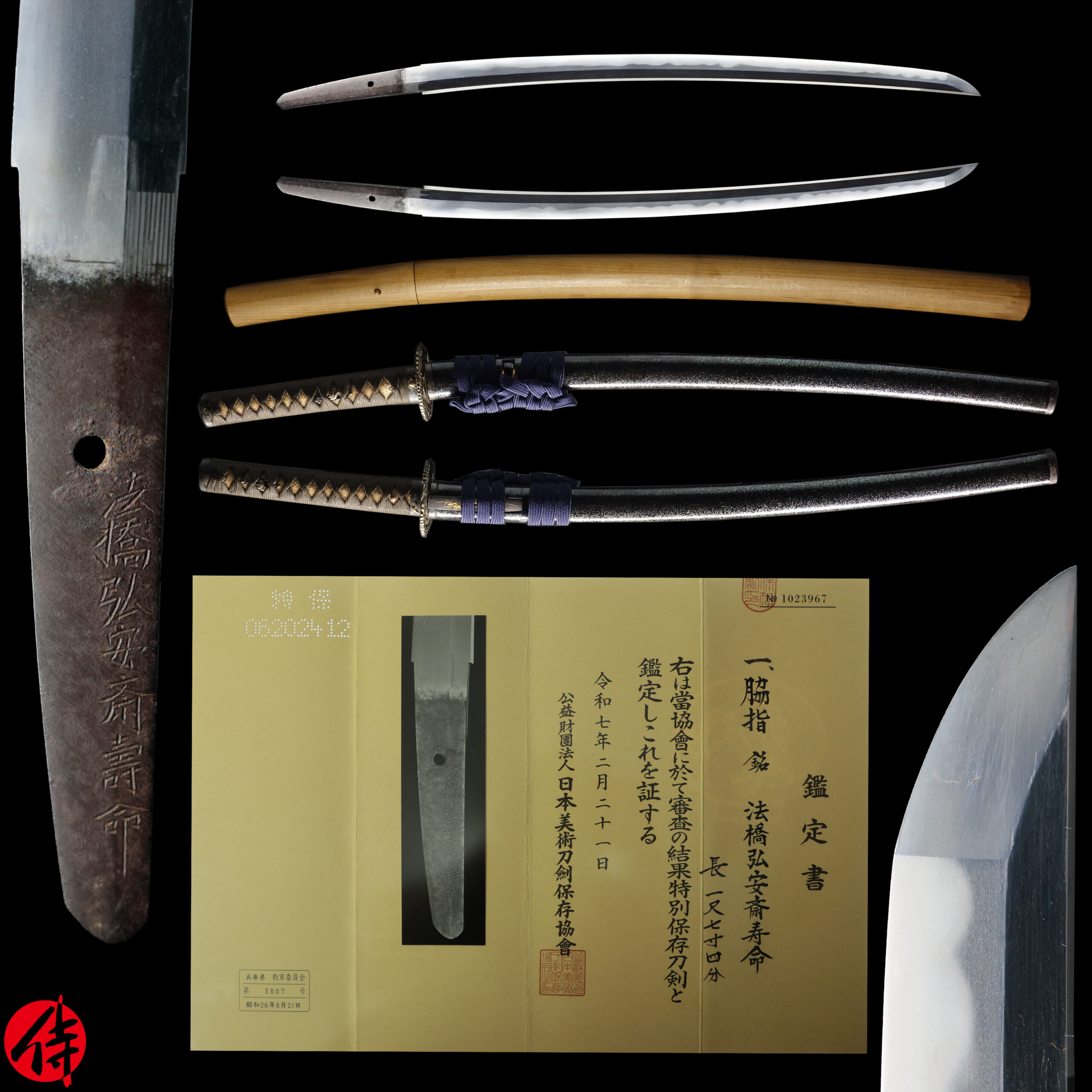
【About us】
Samurai Museum is located in Tokyo, Japan, exhibiting antique artifacts related to the Samurai history. Samurai Museum Shop is the place for those who are interested in Japanese culture and craftsmanship. We deal with antique Samurai swords/armor, traditional crafts made in Japan and so on.
【Japanese Sword& Export Process】
The Japanese swords we deal with are hand-forged edged swords made in Japan. It was made from the traditional carbon steel called TAMAHAGANE(玉鋼). Samurai Museum is familiar with the proper legal procedure for an antique/ authentic Japanese sword to be exported from Japan. We have sent more than 1000 Japanese swords for the past few years (~2025) to amazing owners who appreciate its historical value.
Each Japanese sword is registered under the Agency for Cultural Affairs and the Board of Education in Japan. They issue a registration paper for each Japanese sword for its owner in Japan to legally possess it. The Japanese sword with its registration paper means it was traditionally hand-forged in Japan.
To legally export the sword from Japan to other countries, we will have to apply for its permit to the Agency for Cultural Affairs(Bunkacho) and return the original registration paper to the Board of Education. It normally takes around 2-4 weeks to receive this permit after submitting required documents. And we would like you to expect at least 1-1.5 months for your order to arrive at your given address after you ordered. For more detailed info, please click here.
It is allowed for residents in Japan to own authentic Japanese swords without a special license as long as they come with registration papers. Please feel free to contact us if you are a resident of Japan, whether temporarily or permanently. We will also assist you when you leave Japan and need to obtain the export permit.
【Payment Method】
We accept payment through Stripe (Credit card), PayPal, Apple Pay or ChromePay, all of which are secure payment methods. Also, you don’t need to make an account on Stripe for the checkout. If you prefer other payment method, please contact us. After confirming your payment, we will apply for an export permit. You may either pay in JPY, USD, AUD, CAD,EUR CHF or GBP. The price is set in Japanese Yen. Prices in other currencies are automatically calculated based on the latest exchange rate.

* If the amount is above 1 million JPY, Stripe or wire transfer will be the only options for payment.
【Shipping】
We have shipped authentic Japanese swords to the USA, UK, Canada, Mexico, Germany, France, Hong Kong UK, and Australia. If you don’t live in these countries and like to order, please contact us first before making a purchase. We offer Free International Shipping as long as we can send antique Japanese swords by EMS.
We normally ship by EMS(Express Mail Service) provided by Japan Post. We will send you a tracking number for your order as soon as we hand it to the post office. We will put 100 % insurance on the shipping document without any extra charge. Based on the total amount, there might be a duty tax or other fee for you to pay, depending on the countries. We use package cushioning to protect the item and put it in a PVC pipe, which is one of the most secure packages because of its durability.
It will normally takes 5-14 days for the item to arrive at your given address after we dispatch it. Time of delivery is estimated as accurately as possible by the carrier but does not take into account any delays beyond our control such as by inclement weather, post office holiday seasons.
* If you live in Australia and like to purchase an authentic Japanese sword, please click here to know the detail.

【Review】
Here is one of the reviews we received from a customer who purchased an authentic Japanese sword from us. For more reviews, please click here.
“My experience overall with the whole process was wonderful. I had many questions about the history and process to purchase these treasures. All my questions were answered very timely and complete. The staff is very knowledgeable and very well versed if any questions do arise.”
【How to make sure the condition】
Please keep in mind that what you are going to purchase is an antique item. We uploaded high resolution photos for you to check its condition thoroughly. If you like to see more photos with different angles, please feel free to contact us. We will be happy to send them to you so that you can make informed decision. It is essential for us to know that you are happy with your choice of a sword. and we are prepared to use the best of our ability to serve you.
【How To Contact Us】
Please contact us through email, Facebook Messenger or Live Chat if you have any questions. You can find each icon on the right side of the website. Please click one of them to reach us. We will reply to you within 1-2 business days.
【The Art of Nihonto (Japanese Sword)】
Samurai’s history is a profound, eloquent legacy of ancient Japanese warriors in which millions of people worldwide are being fascinated. If you like to find out the art of Nihonto, please click here.
【A Guide to Japanese Sword Maintenance】
After acquiring an genuine Japanese sword, it is also important to know how to take good care of it. Here is the special video for you. Mr. Paul Martin, Japanese sword expert, shows you how to give proper maintenance to your sword. By mastering how to clean the Japanese sword, its aesthetic beauty will last forever.
When you purchase a Japanese sword from us, you can get a Free Japanese sword maintenance kit. It comes with four tools(Choji Oil, Uchiko Whetstone Powder, Peg remover, Oil Applicator). By watching the video instruction above , you can enjoy learning how to maintain your Japanese sword while appreciating it. If you have any difficulty assembling the sword or cleaning the blade, you can feel free to contact us.
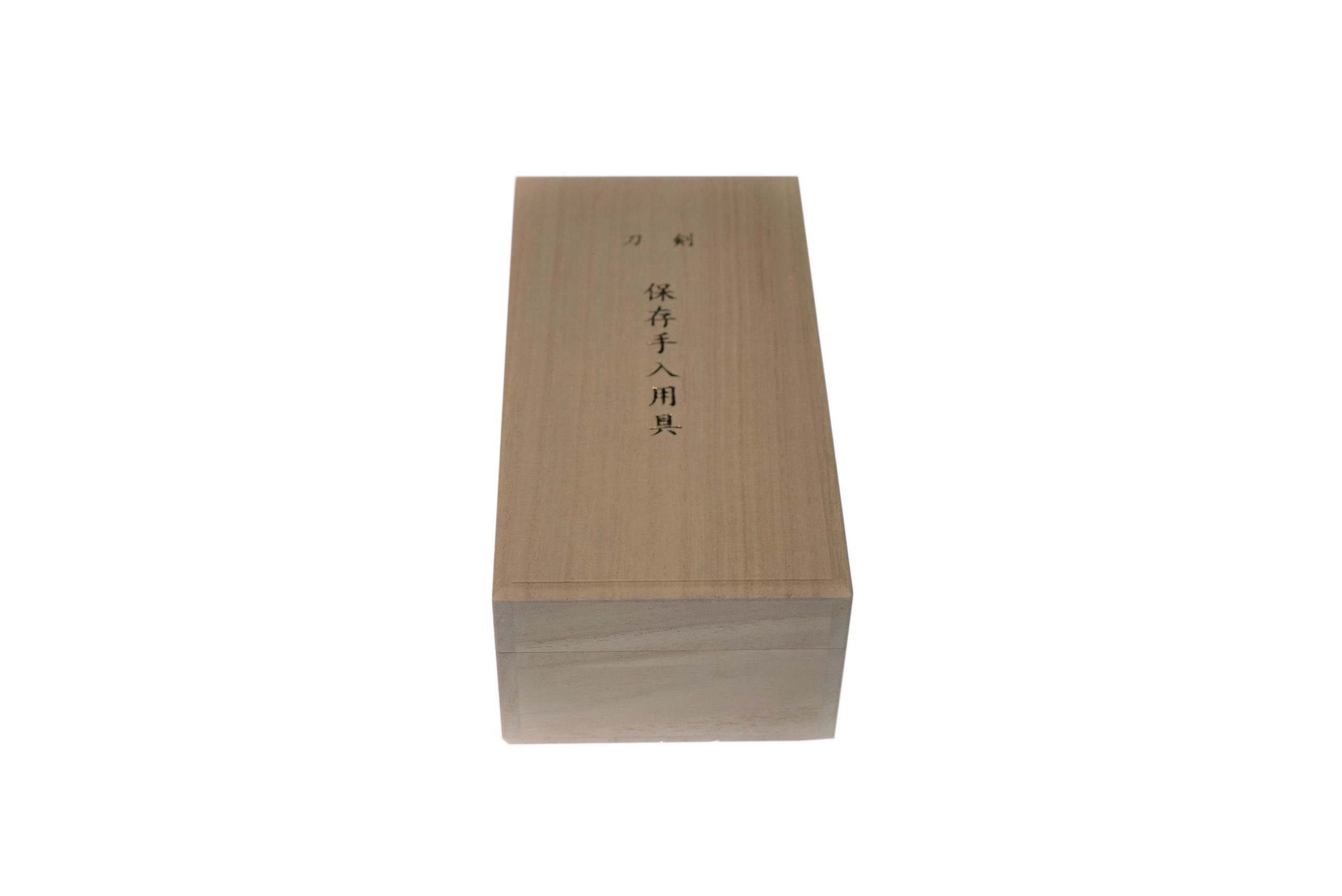
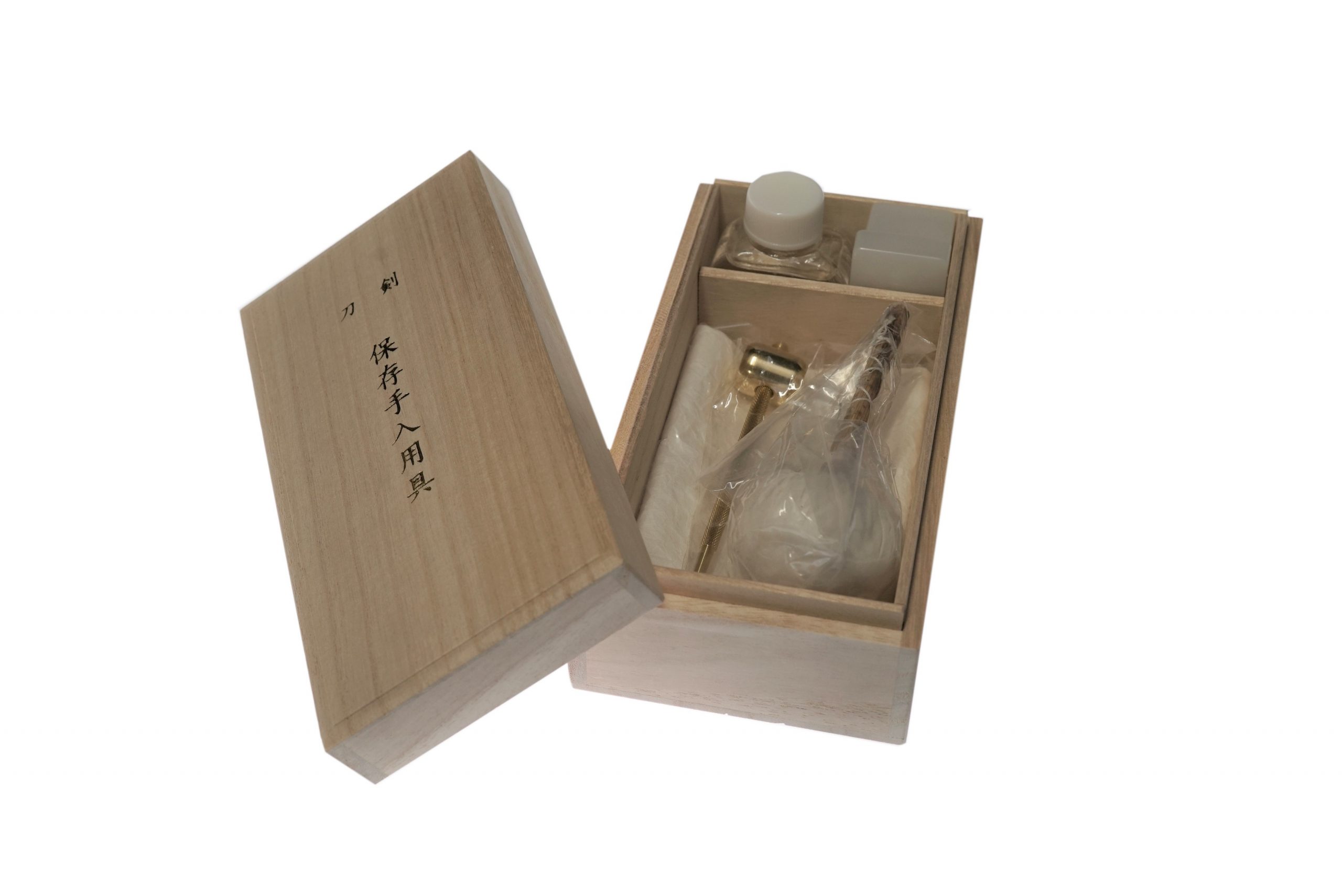
MORE ANTIQUE JAPANESE SWORD FOR SALE
SWORDS WITHOUT CERTIFICATES FOR SALE
LEARN JAPANESE SWORD TERMINOLOGY
Thank you for reading all the information on the page. If you have any difficulty choosing the right Japanese sword for you, we will be more than happy to help you find the one that speaks to you the most. Please feel free to contact us.
